
- Main Idea Worksheets
- Capitalization
- Alphabet Coloring Pages
- Preschool Letter Worksheets
- Bubble Letters
- 5 Letter Words
- Words for Kids (A-Z Word Lists)
- Days of the Week
- Phonemic Awareness Worksheets
- Phonics Worksheets
- Sight Words
- Kindergarten Spelling
- 1st Grade Spelling
- 2nd Grade Spelling
- 3rd Grade Spelling
- Anchor Charts
- All About Me Templates
- Christmas Worksheets
- Cursive Writing
- Frayer Model Templates
- Fun Fact Friday
- Main Idea Graphic Organizers
- Noun Worksheet Maker
- Printable Lined Paper
- Reading Logs
- Sight Words Bingo
- Writing Prompts
- By grade, concept, theme
- By Common Core Standards
- By NGLS Standards

Book Report Templates
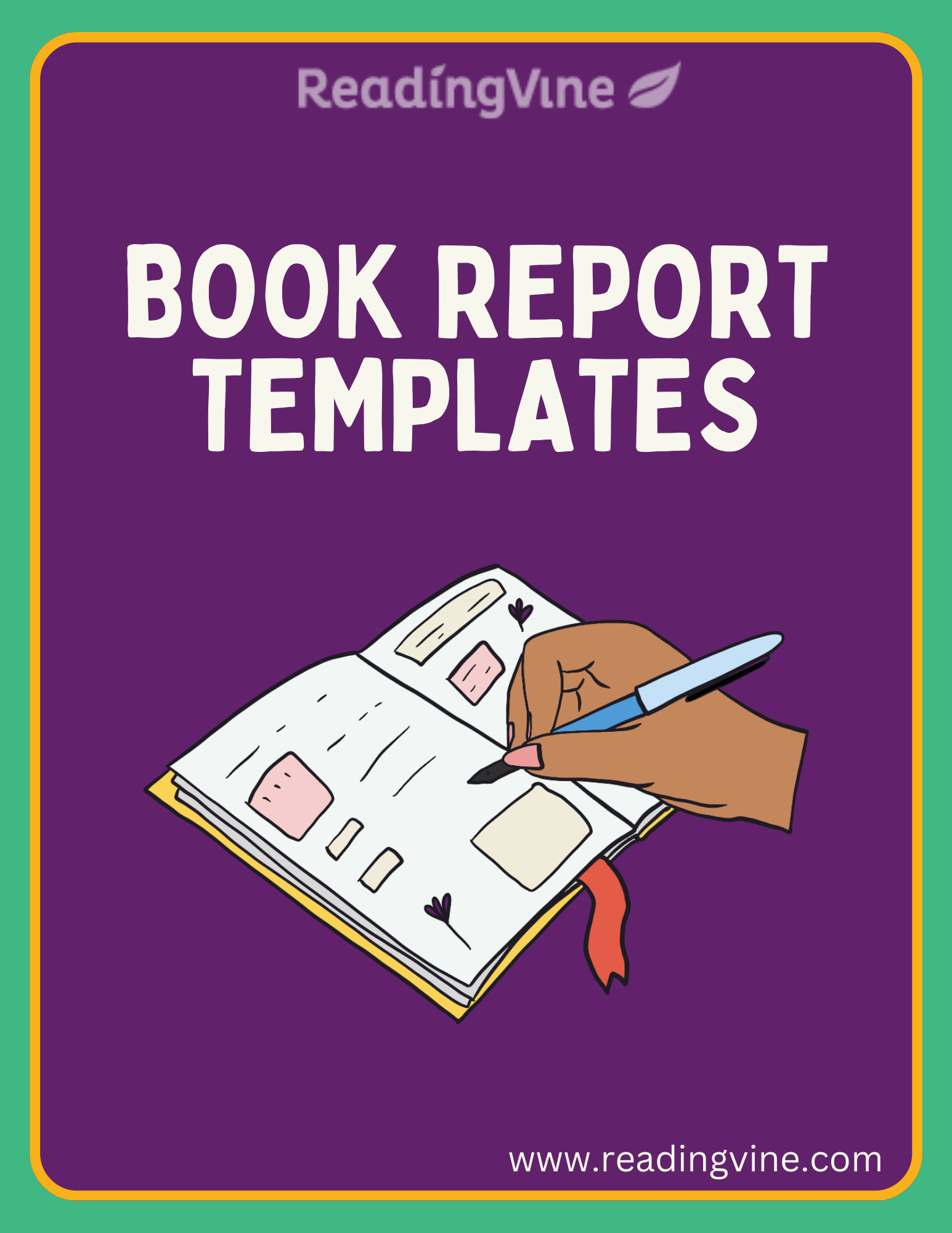
Book reports often ask students to summarize, reflect, and share their ideas. We’ve created a series of book report templates that you can use or adapt based on a variety of learning needs. While this task may reflect individual preferences and insights, it can be collaborative. Students can share in gallery walks, small groups, or large groups. Displaying book reports near your classroom library can allow you to curate a more meaningful classroom book collection and allow peers to interact in an unexpected way. Some of the earliest work with longer writing tasks is cultivated through the experience of crafting a book report. No matter how young your learners may be, fostering a love of reading and providing opportunities for children to write about what they read is critical.
Book Report Templates (Printable PDFs)
One of the most important steps of helping students understand how to craft a book report lies in their ability to choose the books they read and how they want to report on what they’ve learned. It is always useful to review book report options together in class in order to create a firm foundation that students can return to again and again. Since book reports can be a staple task in many elementary school classrooms, offering choice in how students craft and create reports will make the experience more engaging.
We’ve created a variety of printable book report templates below for different learners. For instance, we have an English language and Spanish language book report template that students can use to document character names, setting, and reflect on their favorite parts of a text! Additionally, we’ve crafted book report organizers for fiction and nonfiction texts, so you can appeal to learners who love different genres and make your curriculum more inclusive. Finally, we’ve also created a few options for those students who need more challenge. In these book reports, students extract quotes of significance, analyze them, and offer their insights on what the text teaches readers.
All of our book report templates encourage students to reflect on their interest in the text. This is critical for their reflection and ability to connect with their reading experiences.
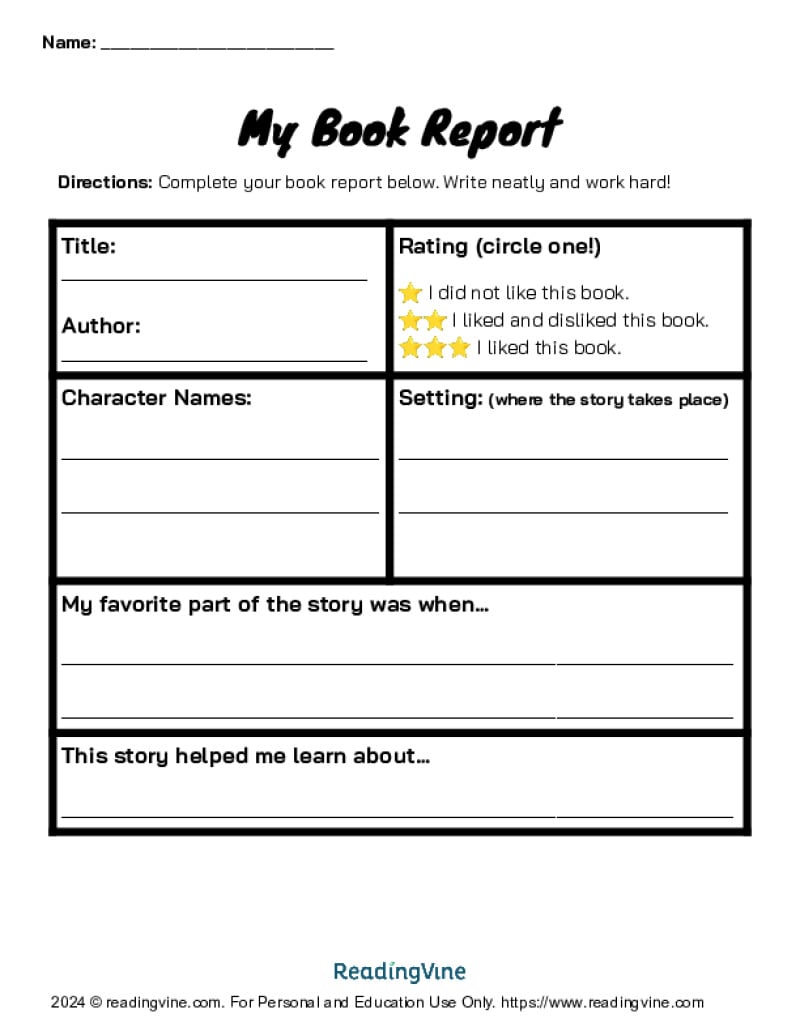
Students complete the book report by writing the title, author, Character names, setting and their favorite part of the story.
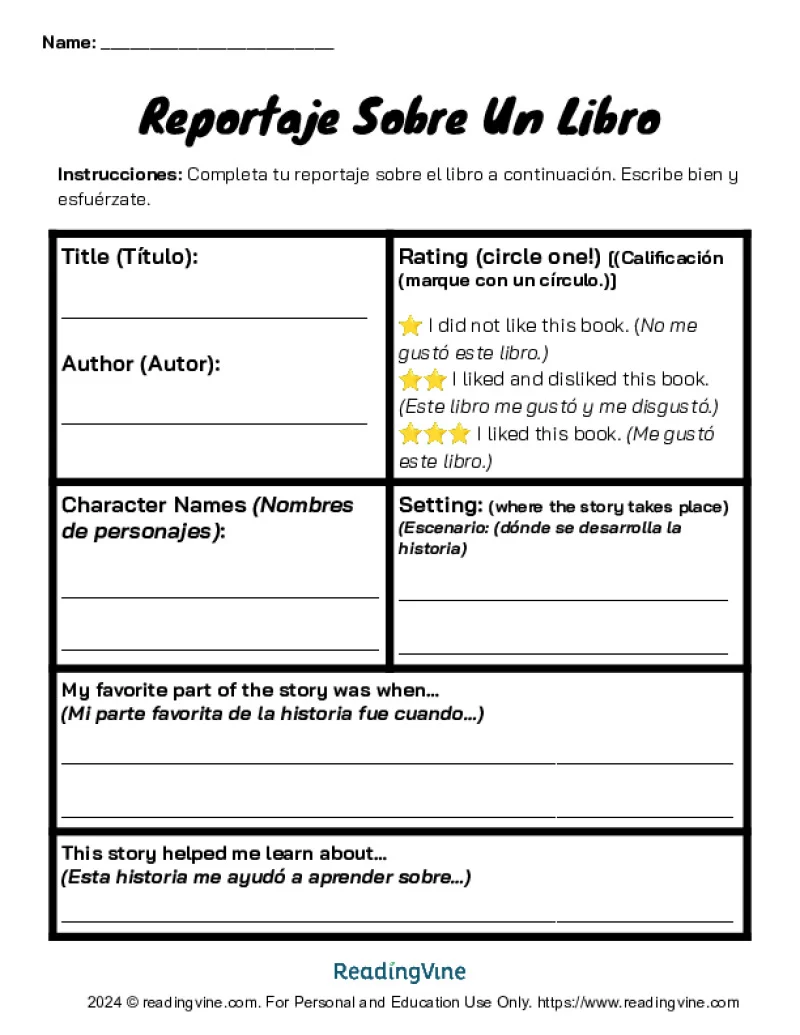
This is the same book report template but in Spanish.
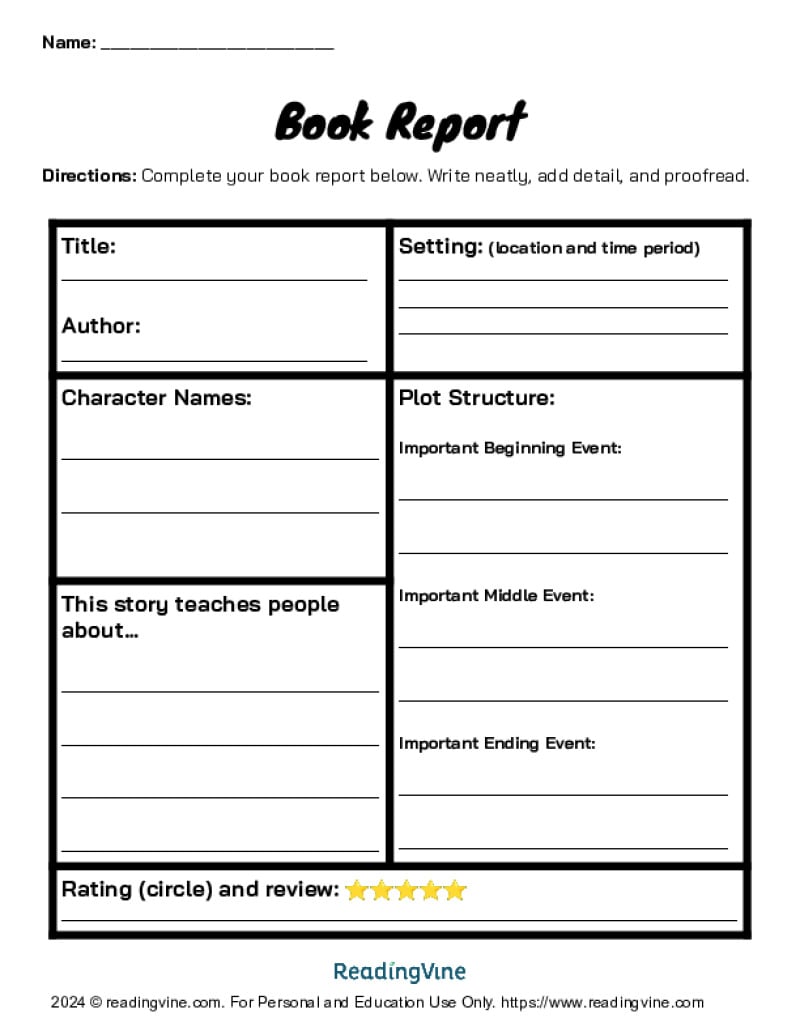
With this template, 4th - 5th grade students enter the title, author, character names but also enter the plot structure and what the story can teach people. Students also rate the book.
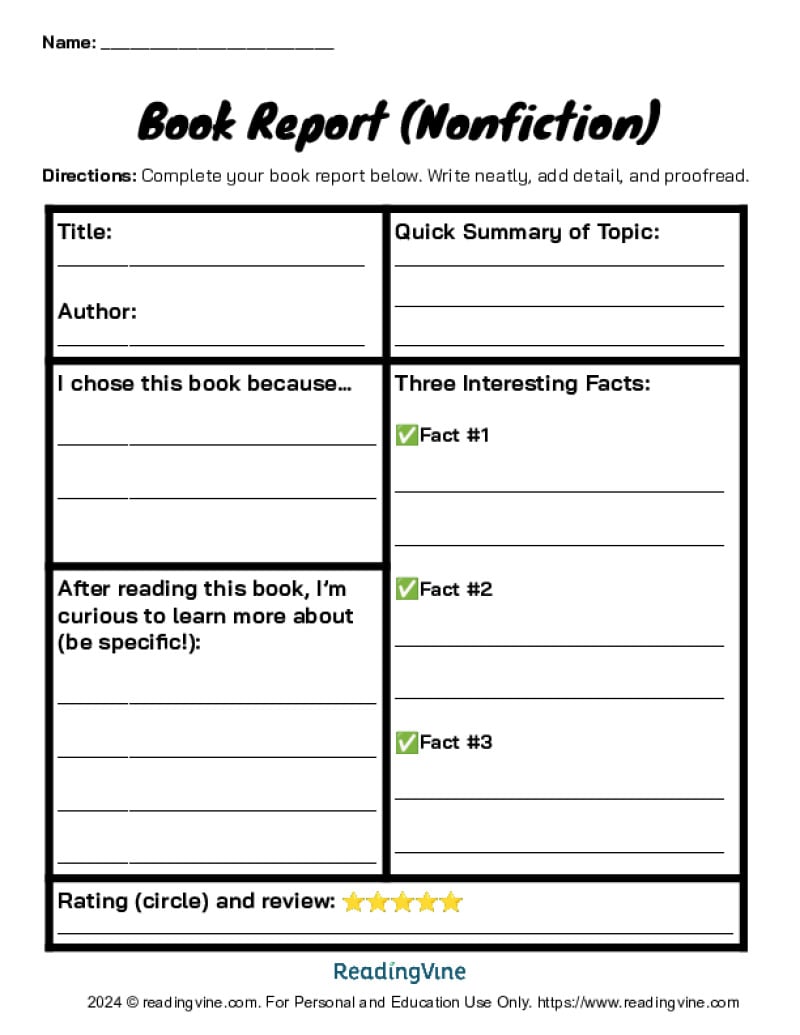
A template for nonfiction books. The student enters basic book information plus three interesting facts and what they are most curious about after reading the book.
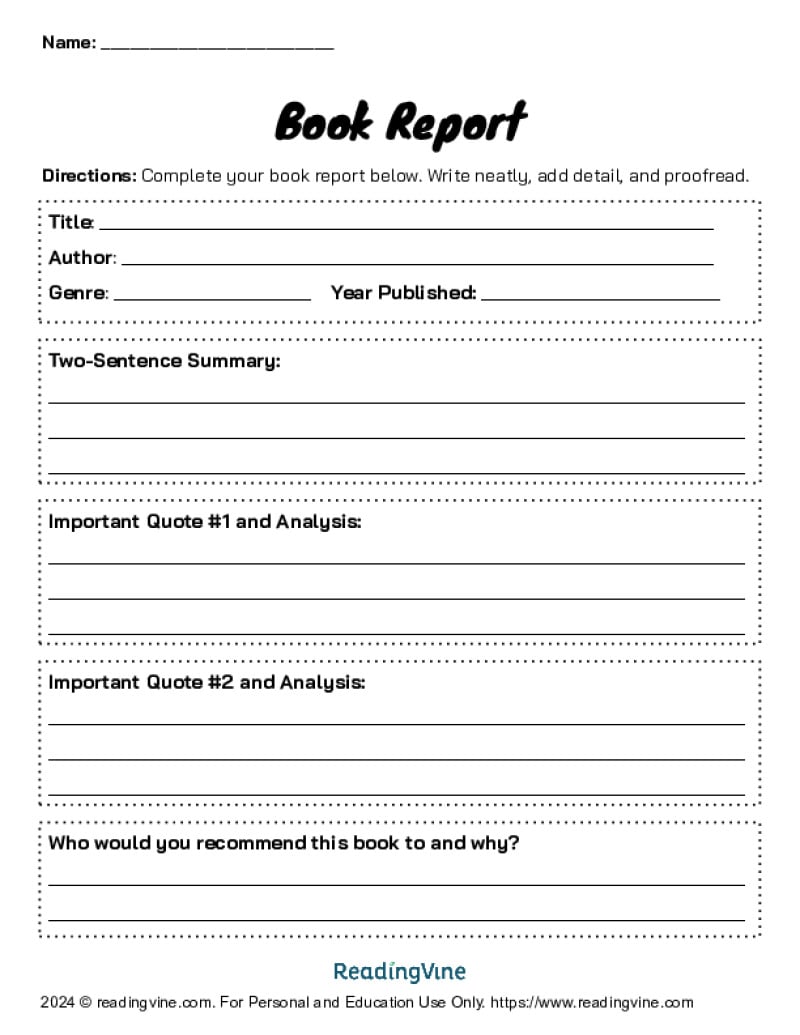
With this 6-8th grade template, students write a two-sentence summary, important quotes and whether they recommend the book and why.

Students explain, in two sentences, what the text is about, identify three important events in the text, and choose one quote they think is most important and then analyze its importance.

FREE Printable Book Report Template pdf 1st, 2nd, 3rd, 4th Grade
- FREE Printables
Are you tired of ads too?
For a small fee you can get this site – and all the free goodies – 100% ad-free!
Make sure kids are understanding what they read with this free book report template . This 1st grade book report is a handy, NO PREP way to ensure early readers are understanding what they are reading. The book report template 3rd grade has a spot for first grade, second grade, third grade, and fourth grade students to write down book title, author, rate the book, tell their favorite part, give a summary of the book, and more. This is such a handy, free printable, book report template 2nd grade . Simply grab the free book reports and you are ready to go!

Book report template
Book reports don’t have to be difficult! Young children need practice writing, summarizing the major parts of the book, and ensuring they understand what they are reading, but staring at a blank page isn’t going to help your early reader succeed! These free book report tempaltes allow grade 1, grade 2, grade 3, and grade 4 students to write a book report EASILY! Use the 2nd grade book report with guided prompts and ruled lines to make writing a book report easy for kids. Use as many of the pages in the free printable book report template as you think is appropriate for your child.
Whether you are a parent, teacher, or homeschooler – you will love this NO PREP, 1st grade book report template ! Use it at home, in the classroom, as summer learning, or any other use you need. Just print the 4th grade book report template and you are ready to write a book report!
Plus don’t miss our recommendations for children’s book lists , free english worksheets , and 3rd grade worksheets .
Free printable book report template
Start by scrolling to the bottom of the post, under the terms of use, and click on the text link that says >> ___<<. The printable book report template pdf file will open in a new window for you to save the freebie and print the template. Now you are ready to start writing book report for kids !
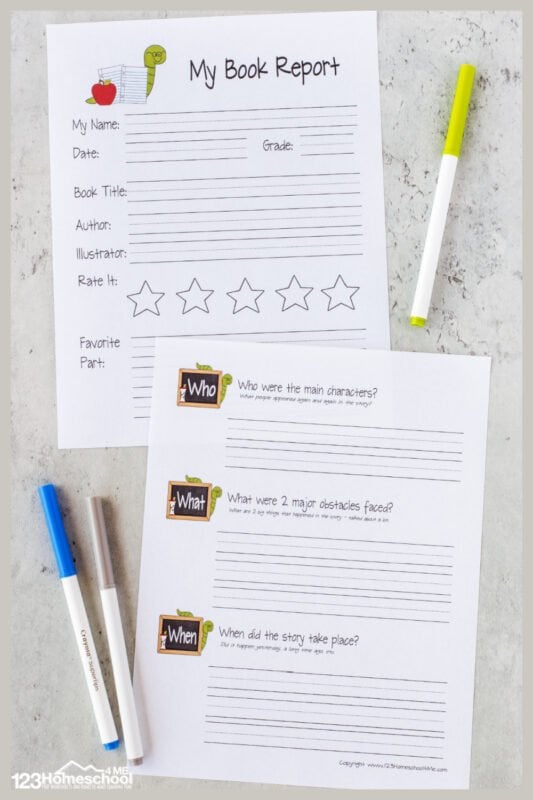
Book report template 3rd grade
It is important to ensure that they are understanding what they are reading. Reading comprehension is a key homeschool skill that will serve them their entire life. Having kids complete 1st grade book report template is just one of the ways we can check if they are understanding what they are reading. I created this free 1st grade book report to make it fun and easy to see how my child is doing.

Free book report template
Print the pages of the free 2nd grade book report template pdf and you are ready for your child to complete the book report form. This book report template 2nd grade is handy for a wide variety of ages. The basic parts of a book report are the same. What will vary the most by grades is the complexity of sentences, vocabulary, spelling, correct punctuation, and reading level of the books.

Book report template pdf
My book report.
- students name
- students grade
- date book report written
- author of the book
- book illustrator
- rate the book out of 5 stars
- favorite part
- WHO were the main character
- WHAT were two obsticles faced
- WHEN did the story take place
- WHERE did the story take place
- WHY did you like or not like the story
- HOWdid you feel about the main characters

Book report template 4th grade
While older students are becoming proficient writing, it can still be helpful to have a simple template to allow children to just fill in the pages. This 4th grade book report template allows students to focus on writing good sentences with correct spelling instead of trying to figure out what to include in their book report.

Worksheets for Grade 1
If you have a 1st grader and you are looking for more fun, hands on 1st grade Worksheets , games and activities to make learning fun – you will love these resources!
- 100 Books 1st Graders can Read Themselves with free 1st grade reading books pdf free
- Fun-to-Read Chapter Books for 1st Graders
- Free Printable 1st Grade Book Report template
- Kid favorite, FREE Cut and Paste Worksheets for a variety of subjects!
- Sight Words Printable List
- First Grade Word Search
- Phonics Dab the th worksheets
- sh, ch, th word Digraph Games
- Ending Blends Worksheets with do a dot markers
- Cut and Paste L Blends Worksheets
- LOTS more free printable phonics worksheets and games
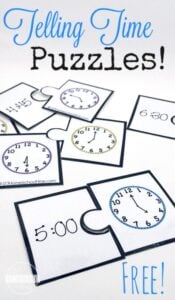
Free printable worksheets for 1st grade
Looking for even more grade 1 worksheets to review skills while having fun? Check out these resources:
- 1st Grade Reading Games – Reading the Easy Way 1st Grade
- Fun, hands-on Counting Coins Games
- Over 500 pages of Kindergarten Writing Prompts Free
- Sentence Scramble Worksheet s
- Princess Color by Sight Word Worksheets
- Time Puzzles make learning to use a clock FUN
- Gumball Math Worksheets to practice addition & subtraction
- Crack the Code Worksheet s for practicing math while having fun
- Bingo Shapes Game
- Color the Coin Money Coloring Pages
- Addition and Subtraction Math Mystery
- Printable Addition Tic-Tac-Toe Game
- Free Hundreds Tens and Ones Worksheets
- Free printable 1st grade math worksheets

1st Grade Science
Dive into some outrageousl fun science with our hands-on experiments and first grade worksheets
- Solar System Worksheets Pack
- Life-size Human Body Project with free printable template
- EASY Lemon Battery Experiment
- 12 Hands-on Battery Experiment Ideas for Kids
- Mind-blowing Magnetic Slime for Kids
- Magnet experiments for Kids
- Balloon Solid, liquid, gas hands-on activities plus other projects
- Phases of the Moon for Kids – worksheets, activities, Oreo moon phases, and more
- Weather Unit with worksheets and hands-on weather activities for kids
- Learn the planet names with this Solar System for Kids Lesson plus tons of other Solar System Project Ideas

Grade 1 Science
Plus don’t miss these worksheets for grade 1
- Learn about Animal Classifications for Kids with these free printable cootie catchers
- Lots of 1st Grade Science Projects
- HUGE Ocean Animals for Kids Unit
- Dive into the amazing world of botany with this plants for kids lessons
- Learn about LOTS of life cycles for kids (panda, spider, watermelon, bee, sunflower, spider, and more!)
- TONS of fun Human Body for Kids activities, expeirments, and free printables too!
- Free Scientific Method Worksheet s

Free first grade worksheets
Help children learn about the great country of the United States with these free printables. Plus don’t miss all our fun, free, and immersive history lessons for kids and our other worksheet for grade 1
- Printable USA Presidents Coloring Pages
- Cute, Free Printable State Coloring Pages
- Free Printable States and Capitals Matching Game
- Free Presidents Worksheets – Learn about all the American presidents
- US States I Spy Worksheets
- Help kids understand where do I live with this clever printable activity
- Learn about American symbols with these Patriotic American Symbols for Kids
- How much do you know about USA for Kids ? Color the flag, look at a map, discover famous landmarks like the statue of liberty,and more!
- American Symbols Worksheets
- Explore American History for kids including lots of fun, hands on activities and free printables
- 4 week lesson about Early Explorers for Kids
- The Colonial America for Kids lesson takes kids on a journey back to the first permanent settlement in America – Jamestown. Students will learn about colonial life with lots of hands on projects like eating Gruel, making a Wattle & Daub house, and creating a tin lantern will make the settlement come alive.
- We will make westward expansion for kids come alive for kids as they learn facts about the time period from about 1783-1898. In addition to learning about the Oregon trail, pony express, gold rush, transcontinental railroad, students will also learn to match animal trails, map the united states, and learn about North American animals too.
- Pennant History Posters to see US History At-a-Glance
- Learn about the Roaring 1920s for Kids – Printable Book to Read, Color, and Learn
- Rosa Parks for Kids Printable Reader to Color and Learn
- Martin Luther King Jr for Kids Printable Reader to Color and Learn
- Free Printable Maps including world map, continents, and country maps with and without labeling
- Ready to dive more in depth? Check out Country Study for Kids – look at 16 countries around the world up close
- Use Lego to explore famous landmarks in countries for kids
- Research and learn with these free Children around the World Worksheets
- Roll into Geography – Printable Geography Games
- You can find all our FREE printable country coloring pages covering over 36 different nations – or jump right to Spain Coloring Pages , China Coloring Pages , Italy Coloring Pages , Chile Coloring Pages , Germany Coloring Pages , and Costa Rica Coloring Pages
- Over 1+ million pages of Free Printable Worksheets

Book recommendations for Kids
- Tons of books for preschoolers and fun world book day activities
- Must Read Kindergarten Reading Books pdf free , free Kindergarten Reading Level Book List, Favorite Read Aloud Books for Kindergarten
- 100 Books for 1st Graders to Read by Themselves – Level 1 Reading Books pdf free , Fun-to-Read First Grade Picture Books , First Grade Read Aloud Chapter Books
- Chapter Books for 1st Graders , 2nd Graders, and 3rd Graders – favorite series to keep kids reading!
- Best Read Aloud Chapter Books for 2nd Grade , Check out these 2nd Grade Reading Books pdf free
- Handy Grade 3 Reading Books pdf FREE
- Free 4th Grade Reading List pdf
- Printable Grade 5 Reading books pdf
- Exciting Historical Fiction Books for Kids and 25 Exciting Historical Fiction Books for 4th Graders
- Alphabet Books for Children, Transportation Books for Kids , Space Books for Kids that are out-of-this-world
- Funny Picture Books for kids of all ages, Sweet Picture Books about Family , Fun Zoo Books for Kids
- Books about community helpers , Beautiful Animal Books for Preschoolers , Preschool Color Books
- Creepy, Crawly Bug Books for Preschool kids, Rhyming Books for Kindergarten , fun-to read fall books for kids , and Preschool emotion books for learning to understand feelings
- See all of our popular kids books to read
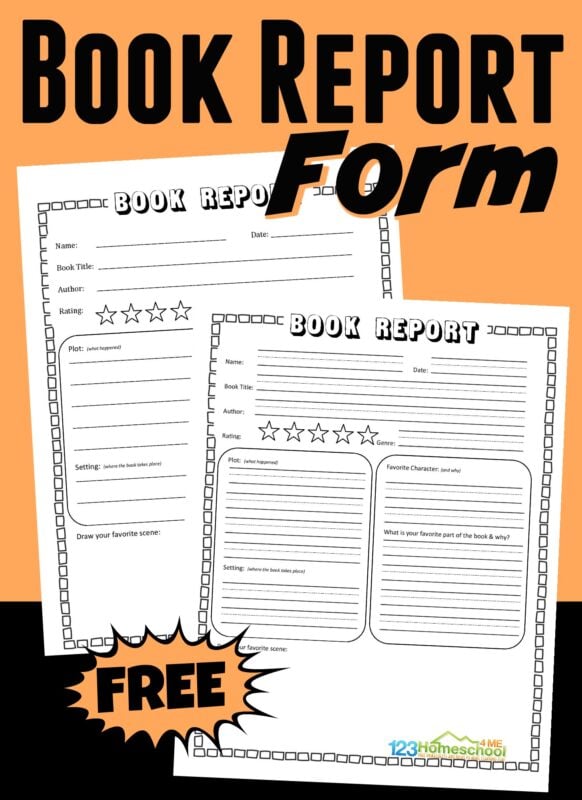
Reading Comprehension
- Handy, Reading Comprehension bookmarks (any book: fiction or non fiction)
- Free Book Report Template for elementary age students or Book Report Worksheets for elementary age kids
- Simple, one page Book Report Template s to ensure kids are understanding the main charaters, setting, and idea of what they are reading
- Super cute Pizza Book Report Idea with Free printable template or sandwich book report freebie
- Free 3rd Grade Book Report template choices
- 26 more clever Book Report Ideas , Ralph Waldo Poetry Worksheets
- See if kids remember the moral of the story with these FREE Aesop Fables Worksheets pdf
- This Library Scavenger Hunt helps kids learn to navigate a library or this Reading Scavenger Hunt
- Bookshelf Reading Log printable – to help encourage kids to read!
- How to teach elementary age students to write a Ralph Waldo Poetry Worksheets
- Free Parts of a Book Worksheet or these parts of a book for kids coloring pages that use playdough, and book reading goals printables
- Plus, grab these super cute, free printable Star Wars bookmarks for kids !

Printable book report template
Before you grab your free pack you agree to the following:
- This set is for personal and classroom use only.
- This printable set may not be sold, hosted, reproduced, or stored on any other website or electronic retrieval system.
- Graphics Purchased and used with permission from
- All material provided on this blog is copyright protected.
Beth Gorden
Beth Gorden is the creative multi-tasking creator of 123 Homeschool 4 Me. As a busy homeschooling mother of six, she strives to create hands-on learning activities and worksheets that kids will love to make learning FUN! She has created over 1 million pages of printables to help teach kids ABCs, science, English grammar, history, math, and so much more! Beth is also the creator of 2 additional sites with even more educational activities and FREE printables – www.kindergartenworksheetsandgames.com and www.preschoolplayandlearn.com. Beth studied at the University of Northwestern where she got a double major to make her effective at teaching children while making education FUN!
Leave a Reply Cancel reply
Your email address will not be published. Required fields are marked *
Thank you for the book report template. Looks great
So glad you can make use of them!
my son is entering second grade and his cousins are entering 3rd and 1st. this will help us with the summer break and keep them at top of their game.
Thank you so much for the great ideas on how to write a book report.
Thanks so much for making this available. We are using this while schools are closed. Our kids really get a little extra push from the fun graphics and great prompts.
This is beautiful! Thank you for making this. We are a homeschool family and my daughter is in 3rd grade and this template will make our book reports so much more fun. We just finished reading The Girl Who Survived together and I really wanted something to help her write down everything that she learned. All the questions you as in the template are perfect. Thanks again
So glad we can help!
Thanks so much!! Going to the library today to find some of these books 🙂
Thank you so much for the resources as a single mom of two boys in different grades it makes it easier to make my lessons.
WTO / Business / Reports / 30 Free Book Report Templates for Grade 1 to 6
30 Free Book Report Templates for Grade 1 to 6
A book report , also known as a critique or review , is a written document that describes or evaluates a piece of fiction or non-fiction.
They are typically assigned to students to demonstrate reading comprehension and persuasive writing abilities. They differ in their scope, with some requiring a simple plot summary and others requiring a critical perspective that analyzes themes, characters, or symbolism in a story.
As great books offer a new perspective on the world, book reports frequently ask students to take a certain stance on the writing. For example: “What statement does The Outsiders by S.E. Hinton make about the lives of teenagers?” The ones assigned to students of lower grade levels may not require them to express their opinion on the book, but all of them start with introductory paragraphs that state basic information like the title and author.
Book Report Templates
For grades 1-2.
Here are the templates that can specifically be used for grades 1 and 2:

For grades 3-4
For grades 3 and 4, the templates and examples are as:
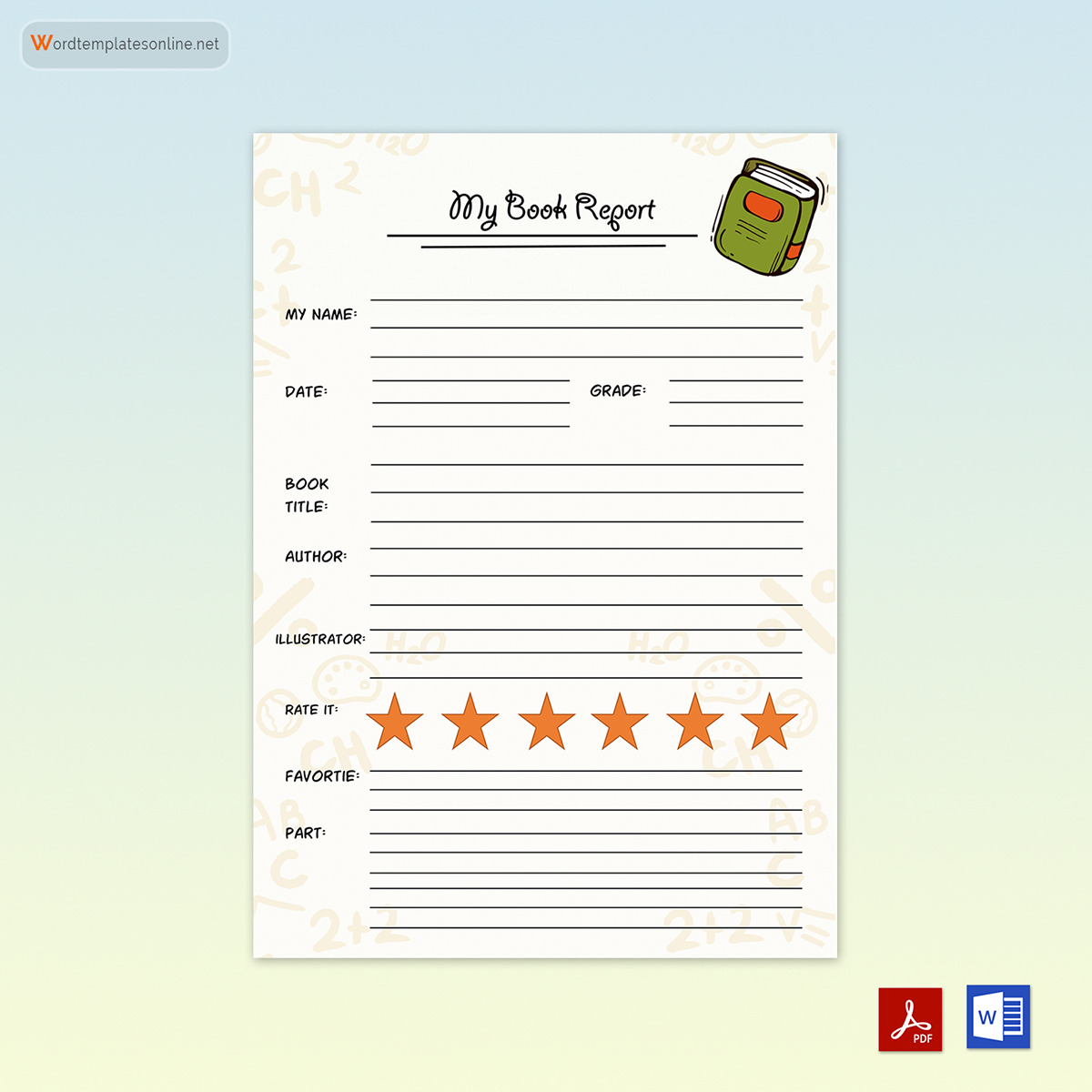
For grades 5-6
Following are the templates that can be used by the teachers or students of grades 5 and 6:
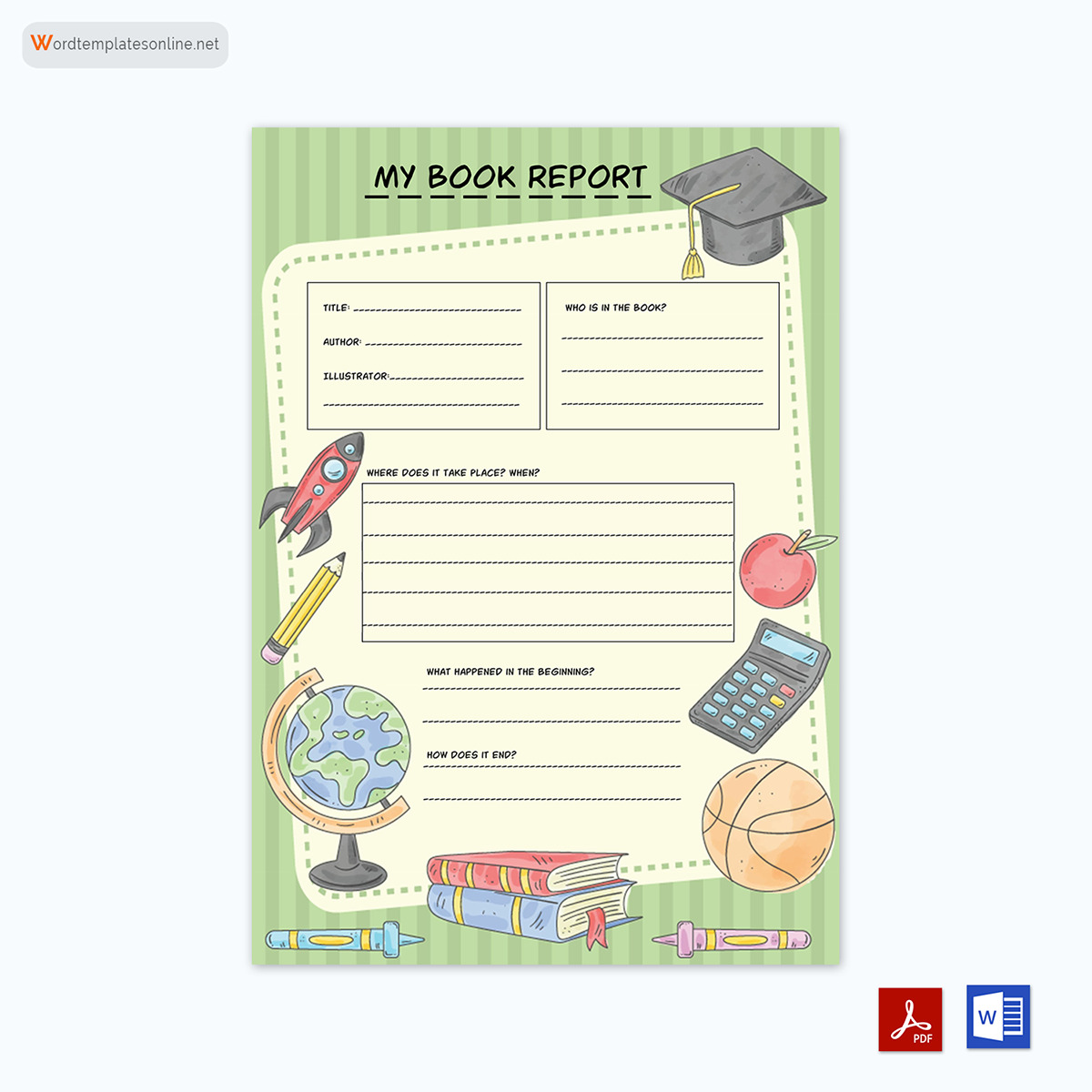
Pre-Writing Considerations of a Book Report
Preparing your ideas before starting can make writing a book report easier and help you save time. So be sure to complete the tasks below before beginning your report to maximize your efficiency and quality of work:
Identify your objective
Your objective is the main statement that you will make in your paper. This statement often answers an assigned question or gives a specific point of view on the story. All of your writing will stem from this objective, which is why it is essential to have it in mind before starting the report. It would be best to choose your quotes and examples according to what will support the point you are arguing in your writing.
Review the rubric
Rubrics or assignment sheets are often provided for students. They outline important information, such as questions to answer, formatting information, and how you will be scored. Reading the rubric before starting the writing process is essential in ensuring that your report caters to your teacher’s expectations.
Read the book
It’s imperative to read the book that you are writing an essay about. However, if you have a choice, try to find a book you think you’d like. While it may seem like a good idea to read an online summary instead of the book, you will probably miss the details you’ll need to support your arguments or observations in the report.
Keep stationary when you read
As you read, have paper and writing utensils at your side to record the page numbers of any quotes you find essential. Alternatively, use sticky notes to mark any valuable passages. If you are reading electronically, there is likely a highlighting or annotating feature to help you document important passages. This will save you the time of flipping back through the book to find examples to use as evidence later.
Look for themes
Themes are the main messages of a story, for example, “the ineffectiveness of revenge.” They can help you make a statement about the meaning and impact of a story in your report. Depending on the assignment, you may write personally about how the themes affected your reading experience. When reading , take note of any themes you encounter. Additionally, keep an eye out for symbols.
Symbols are objects, people, and circumstances featured, often repetitively, in a story that represents an idea beyond their literal contributions to the book. They can clue you into broader themes. For example, the poison used to kill characters may also suggest the poisoning of the mind metaphorically.
Consider your audience
Who will read your paper? Most of the time, the answer is your teacher or other students. However, sometimes you will be asked to write to an imaginary audience unfamiliar with your book, and your goal may be to persuade them to read it. In this case, you mustn’t spoil the book’s ending. Overall, it’s essential to clarify what information or perspective you want your audience to take away from your report.
Craft a rough outline
Create a basic outline using the objectives, themes/symbols, and quotes or examples you noted while reading. For your first draft, the focus is on the logical organization of your ideas. While sentence fluency and grammar will be necessary for the final report, you can hold off on perfecting those elements when crafting a rough outline.
Standard Book Report Outline
As you move from the reading phase to the writing phase, it’s best to use tried-and-true methods of outlining the report. Once you have a good idea of what you will write about, you can plan your paper in a typical five-paragraph format .
This format is based on an introduction, three body paragraphs (unless your teacher asks for more), and a conclusion. The body paragraphs may include a summary of the book and details surrounding the plot and characters.
First, refer to your assignment sheet for the specific content that should be included. Then, take your ideas from the planning phase and sort them into body paragraphs to create a helpful outline.
How do I Write a Book Report?
Information should flow naturally and logically so that the reader can follow your train of thought and see that your arguments, perspective, ideas, and opinions are well supported.
Include each section listed below to ensure that your paper is both thorough and effective:
Introduction
The introduction includes essential information that will establish to your audience what you are writing about and what points you will argue in the remainder of the paper.
The following elements make up a good introductory paragraph:
The first sentence of any piece of writing should capture the reader’s attention and persuade them to read further. For a book report, this could mean including an interesting fact about the book or author, quoting a compelling passage, or even asking the reader a relevant question.
Title and author-name
The title and author should be stated within the first few sentences to avoid confusion.
Other basic information
Many essays include additional classifying information about the book, such as genre, publication information, awards, or background about the author.
Thesis statement
Thesis statements are typically only required in high-school and beyond-level reports. These statements summarize the argument you will make regarding the meaning of the text in the body of the report. For example, you may state that literary devices, characterization, and setting contribute to a particular theme in your assigned book.
Save most of the details for your body paragraphs. Still, an introduction may include basic plot information, such as the setting, the name of the main character, and the general storyline.
Body of the report
The body of the report contains details and explanations that address the topics mentioned in the introduction.
The following sections describe the major elements to include in the body paragraphs of a book report:
Summarizing extensive fiction or non-fiction can be challenging, but luckily, there are many organizational strategies to make it easier. A simple way to organize the plot is by recording the story’s introduction, middle, conclusion, important characters, and setting (including time). You can use this information to form a simple statement.
A popular strategy for one-sentence summaries is to describe the main character, their goals, their obstacle or conflict, how the challenge is overcome, and the outcome.
After falling in love with Prince Eric, Ariel is transformed from a mermaid to a human by the sea witch Ursula at the cost of her voice. She agrees to kiss the prince within three days or turn back into a mermaid and become Ursula’s prisoner. After she does not succeed, Ariel’s father sacrifices himself, but Prince Eric defeats Ursula and saves all of her victims.
Make sure your summary includes the significant conflicts and how they are resolved. You may also note the tone (i.e., lighthearted or ominous) and the point of view (i.e., first-person).
For non-fiction, you can describe an event and its outcome. You can also use a bubble chart to place an essential concept in the center that extends out with details and descriptions. Chapter titles can give you a good idea of the significant subjects the author is addressing. It’s also important to consider the author’s involvement in the text and where they are getting these facts. For both fiction and non-fiction, it’s best to prioritize the major plot points or facts. Make sure you can tie your summary to the overall themes of the work.
Character information
Character details are always crucial in book reports, and character analysis is a report on its own. To convey the necessary information about a character, consider the problems they’re facing, their strengths and weaknesses, their dialogue, and how the reader perceives them. Physical and general personality traits may also be included. Above all, be sure that you can use your character observations to explain their role in the story’s action.
Plot details
When describing the plot, it’s important to go into detail, but only when it contributes directly to the points you are trying to make. For example, you may highlight literary devices that illustrate a specific theme of the work. In general, you should focus on the most crucial plot points, like the main conflict and how it’s resolved.
Personal evaluation/analysis
Many book reports require you to either analyze the meaning of the story or give an opinion. Analysis often involves describing a significant theme and identifying the writing elements that help establish the meaning or message. In a non-fiction context, you may analyze the author’s perspective and point out any biases in the text.
If your paper is more geared toward a personal review, you can evaluate the plot. Were you interested in the story? Use specific examples to explain why. Other ways to connect personally include considering how you relate to the characters, what you learned from the story, and the different ways the book surprised you.
Examples from the text
It’s hard to support your ideas without referencing the text directly. Whether you’re paraphrasing or using quotations, it’s important to cite any content taken from the book. The most common citation styles are MLA, which includes the author’s last name and page number, and APA, which includes the author’s last name and publication year. Be sure to include a “works cited” or a bibliography page at the end of your paper along with your in-text citations.
Your conclusion should summarize the points you’ve made throughout your paper. Therefore, it is partially parallel to your introductory paragraph. However, be sure that your conclusion is non-repetitive and doesn’t restate your introduction exactly. The final paragraph can also state your overall impression of the book if you are writing a personal review. For example, you may summarize the strengths and weaknesses of the piece and its impact on you. Finally, for non-fiction works, you can use the conclusion to make a final statement on the quality of the evidence.
Editing and revising
Unfortunately, the work isn’t done once you type your last statement. You will probably need to look back over your essay a few times to spot grammar mistakes and improve sentence fluency. Reading your report out loud will help you determine if your writing flows naturally and detect more errors. It’s also helpful to ask a friend or family member to read it and offer an audience perspective. When editing, check for formatting mistakes. Your teacher likely guided the font, text spacing, and citation style that you should use in your work. Finally, it doesn’t hurt to use a spellcheck program to catch any last mistakes before submitting the assignment.
Final Remarks
Taking the time to jot down ideas and craft a proper outline is key to writing a high-quality book report. The best papers also include relevant details cited in the text. It tests your reading comprehension, your persuasive skills, and your ability to summarize. It often requires you to make comparisons and express different perspectives. No matter how well a student meets these challenges and supports their argument, a sloppy paper full of grammatical errors will read poorly. Therefore, the planning, drafting, writing, and editing/revision stages are vital to crafting a great one. When you’re prepared, writing a book report is not as hard as it may seem. However, it is often at least a three-day commitment, considering that you don’t have all day to dedicate to the assignment. Using a free template, such as the one provided on this page, can help accelerate the process and ensure that your writing is appropriately organized. With all the above tips in mind, you will be well on your way to high marks and a smooth writing experience.
About This Article

Was this helpful?
Great! Tell us more about your experience
Not up to par help us fix it, keep reading.

10 Free Homeschool Report Card Templates

12 Free Class Schedule Templates

10 Free School Report Card Templates (Editable)

Free Lesson Plan Templates for Teachers (Editable)
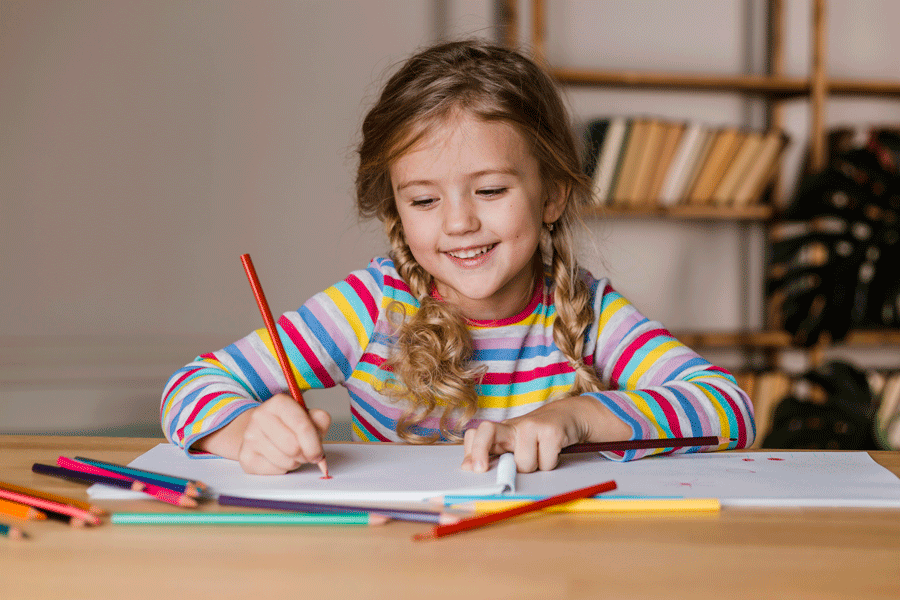
Graphics , Personal
Free printable coloring pages for kids (pdf).

Business , Planners
Free test plan templates & examples (word).

Business , Reports
How to write a white paper (20 free templates).

35 Free Course Syllabus Templates (Editable) – Word | PDF

12 Free Kindergarten Newsletter Templates

12 Perfect Examples of Salutatorian Speech

12 Free Yes No Flowchart Templates (PowerPoint)
Thank you for your feedback.
Your Voice, Our Progress. Your feedback matters a lot to us.
- Real Estate
Second Grade Book Report Template
- Paper Templates
- Book Template
- Book Report Template
Download Second Grade Book Report Template
Linked topics.
Related Documents
- Sixth Grade Book Report Form
- 4th Grade Book Report Template
- First Grade Book Report Template
- Fourth Grade Book Report Template: Fiction
- 4th Grade Book Report Slideshow Plan
- Third Grade Book Report Template
- Summer Book Report Form for Students Entering 6th Grade
- 5th Grade Summer Book Report Template
- Book Report Format for Students Entering 6th Grade
- Book Jacket Book Report
- Science Fiction Book Report Template
- Mystery/Suspense Book Report Template
- High School Book Report Template
- Cereal Box Book Report Template
- Dynamic Indicators of Basic Early Literacy Skills Assessment Form - Second Grade
- Book Jacket Book Report Template - Varicolored
- Book Jacket Book Report Template - Black and White
- Cereal Box Book Report Template - With Picture
- Ar Book Report Form Template - Accelerated Reader
- Cereal Box Book Report Template - Without Picture
- Convert Word to PDF
- Convert Excel to PDF
- Convert PNG to PDF
- Convert GIF to PDF
- Convert TIFF to PDF
- Convert PowerPoint to PDF
- Convert JPG to PDF
- Convert PDF to JPG
- Convert PDF to PNG
- Convert PDF to GIF
- Convert PDF to TIFF
- Compress PDF
- Rearrange PDF Pages
- Make PDF Searchable
- Privacy Policy
- Terms Of Service
Legal Disclaimer: The information provided on TemplateRoller.com is for general and educational purposes only and is not a substitute for professional advice. All information is provided in good faith, however, we make no representation or warranty of any kind regarding its accuracy, validity, reliability, or completeness. Consult with the appropriate professionals before taking any legal action. TemplateRoller.com will not be liable for loss or damage of any kind incurred as a result of using the information provided on the site.
How to Write a Book Report (+ Book Report Example)
Download for free, specific tips for writing effective book reports..
Write better book reports using the tips, examples, and outlines presented here. This resource covers three types of effective book reports: plot summaries, character analyses, and theme analyses. It also features a specific book report example for students.
| Add to Folder | |
|---|---|
| creative writing | |
| children's book | |
| activities | |
| classroom tools | |
| language arts and writing | |
| vocabulary |
How to write a book report (+ book report example)
Whether you're a student looking to show your comprehension of a novel, or simply a book lover wanting to share your thoughts, writing a book report can be a rewarding experience. This guide, filled with tips, tricks, and a book report example, will help you craft a report that effectively communicates your understanding and analysis of your chosen book.
Looking for a printable resource on book reports? See our Printable Book Report Outlines and Examples
What is a book report?
Book reports can take on many different forms. Writing a book review helps you practice giving your opinion about different aspects of a book, such as an author's use of description or dialogue.
You can write book reports of any type, from fiction to non-fiction research papers, or essay writing; however, there are a few basic elements you need to include to convey why the book you read was interesting when writing a good book report.

Types of book reports
Three types of effective book reports are plot summaries, character analyses, and theme analyses. Each type focuses on different aspects of the book and requires a unique approach. These three types of book reports will help you demonstrate your understanding of the book in different ways.
Plot summary
When you are writing a plot summary for your book report you don't want to simply summarize the story. You need to explain what your opinion is of the story and why you feel the plot is so compelling, unrealistic, or sappy. It is the way you analyze the plot that will make this a good report. Make sure that you use plenty of examples from the book to support your opinions.
Try starting the report with a sentence similar to the following:
The plot of I Married a Sea Captain , by Monica Hubbard, is interesting because it gives the reader a realistic sense of what it was like to be the wife of a whaling captain and live on Nantucket during the 19th century.
Character analysis
If you choose to write a character analysis, you can explore the physical and personality traits of different characters and the way their actions affect the plot of the book.
- Explore the way a character dresses and what impression that leaves with the reader.
- What positive characteristics does the character possess?
- Does the character have a "fatal flaw" that gets him/her into trouble frequently?
- Try taking examples of dialogue and analyzing the way a character speaks. Discuss the words he/she chooses and the way his/her words affect other characters.
- Finally, tie all of your observations together by explaining the way the characters make the plot move forward.
In the novel Charlotte's Web , by E. B. White, Templeton the rat may seem like an unnecessary character but his constant quest for food moves the plot forward in many ways.
Theme analyses
Exploring the themes (or big ideas that run throughout the story) in a book can be a great way to write a book report because picking a theme that you care about can make the report easier to write. Try bringing some of your thoughts and feelings as a reader into the report as a way to show the power of a theme. Before you discuss your own thoughts, however, be sure to establish what the theme is and how it appears in the story.
- Explain exactly what theme you will be exploring in your book report.
- Use as many examples and quotations from the book as possible to prove that the theme is important to the story.
- Make sure that you talk about each example or quotation you've included. Make a direct connection between the theme and the example from the book.
- After you have established the theme and thoroughly examined the way it affects the book, include a few sentences about the impact the theme had upon you and why it made the book more or less enjoyable to read.
In the novel Roll of Thunder Hear My Cry , by Mildred Taylor, the theme of racial prejudice is a major catalyst in the story.
How to write a book report

1. Thoroughly read the book
Immerse yourself in the book, taking the time to read it in its entirety. As you read, jot down notes on important aspects such as key points, themes, and character developments.
2. Identify the main elements of the book
Scrutinize the book's primary components, including its main themes, characters, setting, and plot. These elements will form the basis of your report.
3. Formulate a thesis statement
Compose a thesis statement that encapsulates your personal perspective about the book. This should be a concise statement that will guide your analysis and give your report a clear focus.
4. Create a detailed outline
Plan the structure of your book report. This outline should include an introduction, body paragraphs each focusing on a different aspect of the book, and a conclusion.
5. Craft the introduction
The introduction should provide basic information such as the book's title and author, and present your thesis statement. It should engage the reader and make them interested in your analysis.
6. Write the body of the report
In the body of your report, discuss in detail the book's main elements that you identified in step 3. Use specific examples from the text to support your analysis and to prove your thesis statement.
7. Write a strong conclusion
Your conclusion should summarize your analysis, reaffirm your thesis, and provide a closing thought or reflection on the overall book.
8. Review and edit your report
After writing, take the time to revise your report for clarity and coherence. Check for and correct any grammar or spelling errors. Ensure that your report clearly communicates your understanding and analysis of the book.
9. Include citations
If you have used direct quotes or specific ideas from the book, make sure to include proper citations . This is crucial in academic writing and helps avoid plagiarism.
10. Proofread
Finally, proofread your work. Look for any missed errors and make sure that the report is the best it can be before submitting it.

Book report example
Below is a book report example on the novel To Kill a Mockingbird by Harper Lee.
In To Kill a Mockingbird , Harper Lee presents a thoughtful exploration of racial prejudice, morality, and the loss of innocence. Set in the small, fictional town of Maycomb, Alabama, during the Great Depression, the book centers around the Finch family - young Scout, her older brother Jem, and their widowed father, Atticus. Scout's character provides a fresh perspective as she narrates her experiences and observations of the unjust racial prejudice in her town. Her honesty and curiosity, coupled with her father's teachings, allow her to grow from innocence to a more profound understanding of her society's inequalities. The plot revolves around Atticus Finch, a respected lawyer, defending a black man, Tom Robinson, unjustly accused of raping a white woman. As the trial progresses, it becomes clear that Robinson is innocent, and the accusation was a product of racial prejudice. Despite compelling evidence in Robinson's favor, he is convicted, symbolizing the power of bias over truth. The theme of racial prejudice is a significant part of the book. Lee uses the trial and its unjust outcome to critique the racial prejudice prevalent in society. For example, despite Atticus's solid defense, the jury's racial bias leads them to find Robinson guilty. This instance highlights how deeply ingrained prejudice can subvert justice. The book also explores the theme of the loss of innocence. Scout and Jem's experiences with prejudice and injustice lead to their loss of innocence and a better understanding of the world's complexities. For example, Scout's realization of her town's unfair treatment of Robinson demonstrates her loss of innocence and her understanding of societal biases. Overall, To Kill a Mockingbird is a compelling exploration of the harsh realities of prejudice and the loss of innocence. Harper Lee's intricate characters and vivid storytelling have made this book a classic.
The above is an excellent book report example for several reasons. First, it provides a clear, concise summary of the plot without giving away the entire story. Second, it analyzes the main characters, their roles, and their impacts on the story. Third, it discusses the major themes of the book - racial prejudice and loss of innocence - and supports these themes with evidence from the text. Finally, it presents a personal perspective on the book's impact and overall message, demonstrating a deep understanding of the book's significance.
Book report checklist
Always include the following elements in any book report:
- The type of book report you are writing
- The book's title
- The author of the book
- The time when the story takes place
- The location where the story takes place
- The names and a brief description of each of the characters you will be discussing
- Many quotations and examples from the book to support your opinions
- A thesis statement
- The point of view of the narrator
- Summary of the book
- The main points or themes discussed in the work of fiction or non-fiction
- The first paragraph (introductory paragraph), body paragraphs, and final paragraph
- The writing styles of the author
- A critical analysis of the fiction or non-fiction book
Don't forget!
No matter what type of book report you decide to write, ensure it includes basic information about the main characters, and make sure that your writing is clear and expressive so that it’s easy for audiences in middle school, high school, college-level, or any grade level to understand. Also, include examples from the book to support your opinions. Afterward, conduct thorough proofreading to complete the writing process. Book reports may seem disconnected from your other schoolwork, but they help you learn to summarize, compare and contrast, make predictions and connections, and consider different perspectives & skills you'll need throughout your life.
Looking for more writing resources? You can find them in our creative writing center .
Featured Middle School Resources

Related Resources


Book Report Templates for Kinder, First, and Second Grade
- Uncategorized
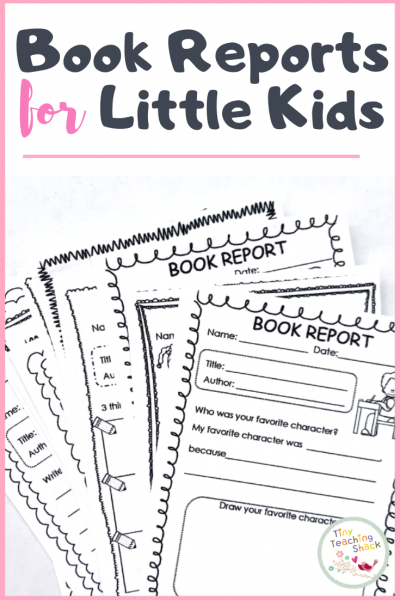
Often, when we think of writing book reports, we think of older or high school students. However, kids of all ages can also learn valuable elements of a book. It will also help them with reading comprehension and improve their writing skills in a fun way. One thing to remember is that it’s always a good idea to make it simple and fun. Our young students are just beginning to read. Using a book report template printable you can keep up that excitement, not turn it into something negative.
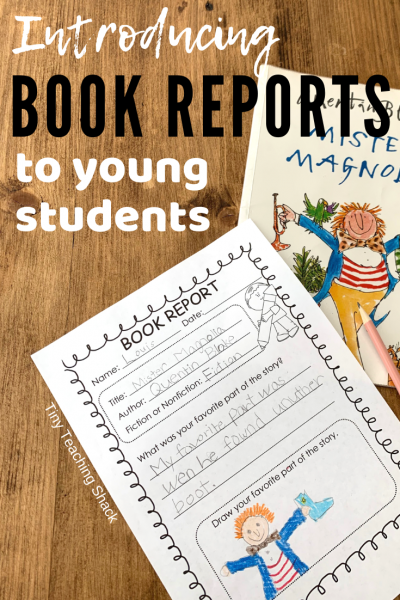
Elements of a Story
Before doing a book report on paper, we want to make sure that the students familiarize all the terms that may come up in a book report such as book title, author, illustrator, and the story elements.
You can fit making posters into your lesson plans to introduce different elements of a story. I like to introduce one or two posters at a time to young children. For example, we will talk about authors vs. illustrators and we will study some of our class’s favorites and find out who the authors and illustrators are. We will learn about setting, and compare and contrast the settings in different stories we’ve read.
I like to do a read aloud and identify parts of a book and elements of a story with my students. The more you talk about them, the more they will be comfortable identifying them in the books they read and using them in sentences. All this oral exercise will prepare them to eventually write their own book report.
These are some of the basic questions you can ask as you introduce different parts of a book and elements of a story.
What is the title of the story?
Is the book fiction or nonfiction?
By looking at the cover and the title, can you guess what the book is about?
What is the setting of the story?
Who are the main characters?
What happened at the beginning, middle, and end of the story?
Free Book Response Cues
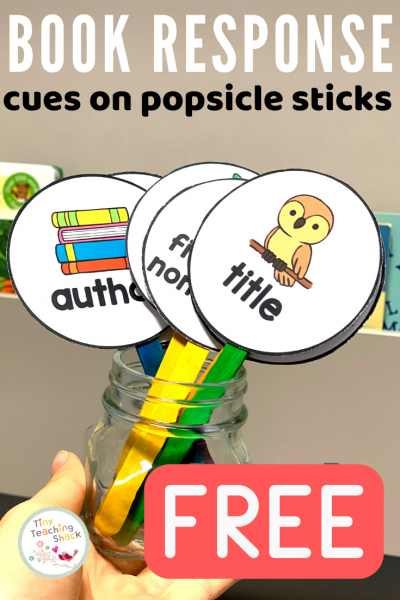
I created these Book Response Cues that you can use once your students are more fluent in identifying the terms in the books they read. Print, cut, and stick them on popsicle sticks or straws, and put them in a little can. After reading a story together, you can have a student pull out a stick to answer the question. This is a great way to do a whole group book study.
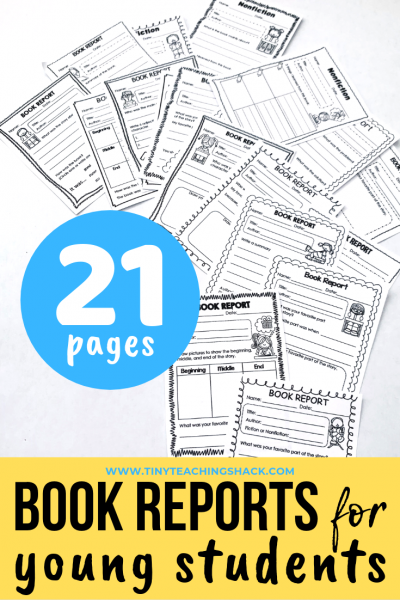
Now, it’s time for a book report! You want to give them something that is kid-friendly and not overwhelming. Let them know they are doing something special- something that older kids do. LEVEL UP! They are growing up!
These printables book report forms were specifically made for kindergarten and first graders who are new to book reports. Writing a book report for young kids should not be intense. For this reason, all of the pages are simple and straightforward, and they focus on a few key words at a time. They can be used in reading/listening centers, as a guided reading extensions, or to assist students in retelling a story.
For me, it is important for my students to familiarize different components and elements of a book, practice writing sentences, and additionally practice handwriting.
Doing a book study together will encourage students to talk about the books that they read. They may have a read a great book and recommend to their friends or they may even talk about a book that was not that fun for them. Reading a book with the intention of reviewing it may even give a little nudge on your students to pay closer attention.
Write a Letter to the Author
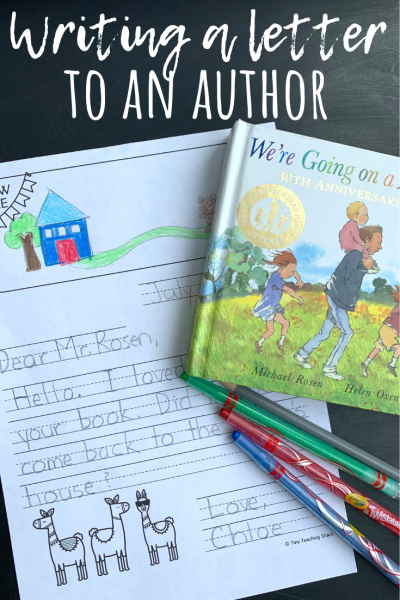
Another thing you can do when using a book report template printable is get your students to write a friendly letter to the author, illustrator, or to one of the characters. Here’s a link to free letter templates you can use. An easy way you can make it fun is by dressing up as one of the characters or select a day or week where your kids can dress up as characters in a book. This is always my favorite part of using a book report template printable with the class! If you have any other fun ideas to share, please share them in the comments below! 🙂
See what others have to say about these book reports!
- Back To School
- Digital Classroom
- End Of Year
- Social Studies
TPT RESOURCES
You may also like....


How to Write a Book Report
Use the links below to jump directly to any section of this guide:
Book Report Fundamentals
Preparing to write, an overview of the book report format, how to write the main body of a book report, how to write a conclusion to a book report, reading comprehension and book reports, book report resources for teachers .
Book reports remain a key educational assessment tool from elementary school through college. Sitting down to close read and critique texts for their content and form is a lifelong skill, one that benefits all of us well beyond our school years. With the help of this guide, you’ll develop your reading comprehension and note-taking skills. You’ll also find resources to guide you through the process of writing a book report, step-by-step, from choosing a book and reading actively to revising your work. Resources for teachers are also included, from creative assignment ideas to sample rubrics.
Book reports follow general rules for composition, yet are distinct from other types of writing assignments. Central to book reports are plot summaries, analyses of characters and themes, and concluding opinions. This format differs from an argumentative essay or critical research paper, in which impartiality and objectivity is encouraged. Differences also exist between book reports and book reviews, who do not share the same intent and audience. Here, you’ll learn the basics of what a book report is and is not.
What Is a Book Report?
"Book Report" ( ThoughtCo )
This article, written by a professor emeritus of rhetoric and English, describes the defining characteristics of book reports and offers observations on how they are composed.
"Writing a Book Report" (Purdue OWL)
Purdue’s Online Writing Lab outlines the steps in writing a book report, from keeping track of major characters as you read to providing adequate summary material.
"How to Write a Book Report" ( Your Dictionary )
This article provides another helpful guide to writing a book report, offering suggestions on taking notes and writing an outline before drafting.
"How to Write a Successful Book Report" ( ThoughtCo )
Another post from ThoughtCo., this article highlights the ten steps for book report success. It was written by an academic advisor and college enrollment counselor.
What’s the Difference Between a Book Report and an Essay?
"Differences Between a Book Report & Essay Writing" ( Classroom)
In this article from the education resource Classroom, you'll learn the differences and similarities between book reports and essay writing.
"Differences Between a Book Report and Essay Writing" (SeattlePi.com)
In this post from a Seattle newspaper's website, memoirist Christopher Cascio highlights how book report and essay writing differ.
"The Difference Between Essays and Reports" (Solent Online Learning)
This PDF from Southampton Solent University includes a chart demonstrating the differences between essays and reports. Though it is geared toward university students, it will help students of all levels understand the differing purposes of reports and analytical essays.

What’s the Difference Between a Book Report and a Book Review?
"How to Write a Book Review and a Book Report" (Concordia Univ.)
The library at Concordia University offers this helpful guide to writing book report and book reviews. It defines differences between the two, then presents components that both forms share.
"Book Reviews" (Univ. of North Carolina)
The University of North Carolina at Chapel Hill’s writing guide shows the step-by-step process of writing book reviews, offering a contrast to the composition of book reports.
Active reading and thoughtful preparation before you begin your book report are necessary components of crafting a successful piece of writing. Here, you’ll find tips and resources to help you learn how to select the right book, decide which format is best for your report, and outline your main points.
Selecting and Finding a Book
"30 Best Books for Elementary Readers" (Education.com)
This article from Education.com lists 30 engaging books for students from kindergarten through fifth grade. It was written by Esme Raji Codell, a teacher, author, and children's literature specialist.
"How to Choose a Good Book for a Report (Middle School)" (WikiHow)
This WikiHow article offers suggestions for middle schoolers on how to choose the right book for a report, from getting started early on the search process to making sure you understand the assignment's requirements.
"Best Book-Report Books for Middle Schoolers" (Common Sense Media)
Common Sense Media has compiled this list of 25 of the best books for middle school book reports. For younger students, the article suggests you check out the site's "50 Books All Kids Should Read Before They're 12."
"50 Books to Read in High School" (Lexington Public Library)
The Lexington, Kentucky Public Library has prepared this list to inspire high school students to choose the right book. It includes both classics and more modern favorites.
The Online Computer Library Center's catalogue helps you locate books in libraries near you, having itemized the collections of 72,000 libraries in 170 countries.
Formats of Book Reports
"Format for Writing a Book Report" ( Your Dictionary )
Here, Your Dictionary supplies guidelines for the basic book report format. It describes what you'll want to include in the heading, and what information to include in the introductory paragraph. Be sure to check these guidelines against your teacher's requirements.
"The Good Old Book Report" (Scholastic)
Nancy Barile’s blog post for Scholastic lists the questions students from middle through high school should address in their book reports.
How to Write an Outline
"Writer’s Web: Creating Outlines" (Univ. of Richmond)
The University of Richmond’s Writing Center shows how you can make use of micro and macro outlines to organize your argument.
"Why and How to Create a Useful Outline" (Purdue OWL)
Purdue’s Online Writing Lab demonstrates how outlines can help you organize your report, then teaches you how to create outlines.
"Creating an Outline" (EasyBib)
EasyBib, a website that generates bibliographies, offers sample outlines and tips for creating your own. The article encourages you to think about transitions and grouping your notes.
"How to Write an Outline: 4 Ways to Organize Your Thoughts" (Grammarly)
This blog post from a professional writer explains the advantages of using an outline, and presents different ways to gather your thoughts before writing.
In this section, you’ll find resources that offer an overview of how to write a book report, including first steps in preparing the introduction. A good book report's introduction hooks the reader with strong opening sentences and provides a preview of where the report is going.
"Step-by-Step Outline for a Book Report" ( Classroom )
This article from Classroom furnishes students with a guide to the stages of writing a book report, from writing the rough draft to revising.
"Your Roadmap to a Better Book Report" ( Time4Writing )
Time4Writing offers tips for outlining your book report, and describes all of the information that the introduction, body, and conclusion should include.
"How to Start a Book Report" ( ThoughtCo)
This ThoughtCo. post, another by academic advisor and college enrollment counselor Grace Fleming, demonstrates how to write a pithy introduction to your book report.
"How to Write an Introduction for a Book Report" ( Classroom )
This brief but helpful post from Classroom details what makes a good book report introduction, down to the level of individual sentences.
The body paragraphs of your book report accomplish several goals: they describe the plot, delve more deeply into the characters and themes that make the book unique, and include quotations and examples from the book. Below are some resources to help you succeed in summarizing and analyzing your chosen text.
Plot Summary and Description
"How Do You Write a Plot Summary?" ( Reference )
This short article presents the goals of writing a plot summary, and suggests a word limit. It emphasizes that you should stick to the main points and avoid including too many specific details, such as what a particular character wears.
"How to Write a Plot for a Book Report" ( The Pen & The Pad )
In this article from a resource website for writers, Patricia Harrelson outlines what information to include in a plot summary for a book report.
"How to Write a Book Summary" (WikiHow)
Using Harry Potter and the Sorcerer’s Stone as an example, this WikiHow article demonstrates how to write a plot summary one step at a time.
Analyzing Characters and Themes
"How to Write a Character Analysis Book Report" ( The Pen & The Pad )
Kristine Tucker shows how to write a book report focusing on character. You can take her suggestions as they are, or consider incorporating them into the more traditional book report format.
"How to Write a Character Analysis" (YouTube)
The SixMinuteScholar Channel utilizes analysis of the film Finding Nemo to show you how to delve deeply into character, prioritizing inference over judgment.
"How to Define Theme" ( The Editor's Blog )
Fiction editor Beth Hill contributes an extended definition of theme. She also provides examples of common themes, such as "life is fragile."
"How to Find the Theme of a Book or Short Story" ( ThoughtCo )
This blog post from ThoughtCo. clarifies the definition of theme in relation to symbolism, plot, and moral. It also offers examples of themes in literature, such as love, death, and good vs. evil.
Selecting and Integrating Quotations
"How to Choose and Use Quotations" (Santa Barbara City College)
This guide from a college writing center will help you choose which quotations to use in your book report, and how to blend quotations with your own words.
"Guidelines for Incorporating Quotes" (Ashford Univ.)
This PDF from Ashford University's Writing Center introduces the ICE method for incorporating quotations: introduce, cite, explain.
"Quote Integration" (YouTube)
This video from The Write Way YouTube channel illustrates how to integrate quotations into writing, and also explains how to cite those quotations.
"Using Literary Quotations" (Univ. of Wisconsin-Madison)
This guide from the University of Wisconsin-Madison’s Writing Center helps you emphasize your analysis of a quotation, and explains how to incorporate quotations into your text.
Conclusions to any type of paper are notoriously tricky to write. Here, you’ll learn some creative ways to tie up loose ends in your report and express your own opinion of the book you read. This open space for sharing opinions that are not grounded in critical research is an element that often distinguishes book reports from other types of writing.
"How to Write a Conclusion for a Book Report" ( Classroom )
This brief article from the education resource Classroom illustrates the essential points you should make in a book report conclusion.
"Conclusions" (Univ. of North Carolina)
The University of North Carolina at Chapel Hill’s Writing Center lays out strategies for writing effective conclusions. Though the article is geared toward analytical essay conclusions, the tips offered here will also help you write a strong book report.
"Ending the Essay: Conclusions" (Harvard College Writing Center)
Pat Bellanca’s article for Harvard University’s Writing Center presents ways to conclude essays, along with tips. Again, these are suggestions for concluding analytical essays that can also be used to tie up a book report's loose ends.
Reading closely and in an engaged manner is the strong foundation upon which all good book reports are built. The resources below will give you a picture of what active reading looks like, and offer strategies to assess and improve your reading comprehension. Further, you’ll learn how to take notes—or “annotate” your text—making it easier to find important information as you write.
How to Be an Active Reader
"Active Reading Strategies: Remember and Analyze What You Read" (Princeton Univ.)
Princeton University’s McGraw Center for Teaching and Learning recommends ten strategies for active reading, and includes sample diagrams.
"Active Reading" (Open Univ.)
The Open University offers these techniques for reading actively alongside video examples. The author emphasizes that you should read for comprehension—not simply to finish the book as quickly as possible.
"7 Active Reading Strategies for Students" ( ThoughtCo )
In this post, Grace Fleming outlines seven methods for active reading. Her suggestions include identifying unfamiliar words and finding the main idea.
"5 Active Reading Strategies for Textbook Assignments" (YouTube)
Thomas Frank’s seven-minute video demonstrates how you can retain the most important information from long and dense reading material.
Assessing Your Reading Comprehension
"Macmillan Readers Level Test" (MacMillan)
Take this online, interactive test from a publishing company to find out your reading level. You'll be asked a number of questions related to grammar and vocabulary.
"Reading Comprehension Practice Test" (ACCUPLACER)
ACCUPLACER is a placement test from The College Board. This 20-question practice test will help you see what information you retain after reading short passages.
"Reading Comprehension" ( English Maven )
The English Maven site has aggregated exercises and tests at various reading levels so you can quiz your reading comprehension skills.
How to Improve Your Reading Comprehension
"5 Tips for Improving Reading Comprehension" ( ThoughtCo )
ThoughtCo. recommends five tips to increase your reading comprehension ability, including reading with tools such as highlighters, and developing new vocabulary.
"How to Improve Reading Comprehension: 8 Expert Tips" (PrepScholar)
This blog post from PrepScholar provides ideas for improving your reading comprehension, from expanding your vocabulary to discussing texts with friends.
CrashCourse video: "Reading Assignments" (YouTube)
This CrashCourse video equips you with tools to read more effectively. It will help you determine how much material you need to read, and what strategies you can use to absorb what you read.
"Improving Reading Comprehension" ( Education Corner )
From a pre-reading survey through post-reading review, Education Corner walks you through steps to improve reading comprehension.
Methods of In-text Annotation
"The Writing Process: Annotating a Text" (Hunter College)
This article from Hunter College’s Rockowitz Writing Center outlines how to take notes on a text and provides samples of annotation.
"How To Annotate Text While Reading" (YouTube)
This video from the SchoolHabits YouTube channel presents eleven annotation techniques you can use for better reading comprehension.
"5 Ways To Annotate Your Books" ( Book Riot )
This article from the Book Riot blog highlights five efficient annotation methods that will save you time and protect your books from becoming cluttered with unnecessary markings.
"How Do You Annotate Your Books?" ( Epic Reads )
This post from Epic Reads highlights how different annotation methods work for different people, and showcases classic methods from sticky notes to keeping a reading notebook.
Students at every grade level can benefit from writing book reports, which sharpen critical reading skills. Here, we've aggregated sources to help you plan book report assignments and develop rubrics for written and oral book reports. You’ll also find alternative book report assessment ideas that move beyond the traditional formats.
Teaching Elementary School Students How to Write Book Reports
"Book Reports" ( Unique Teaching Resources )
These reading templates courtesy of Unique Teaching Resources make great visual aids for elementary school students writing their first book reports.
"Elementary Level Book Report Template" ( Teach Beside Me )
This printable book report template from a teacher-turned-homeschooler is simple, classic, and effective. It asks basic questions, such as "who are the main characters?" and "how did you feel about the main characters?"
"Book Reports" ( ABC Teach )
ABC Teach ’s resource directory includes printables for book reports on various subjects at different grade levels, such as a middle school biography book report form and a "retelling a story" elementary book report template.
"Reading Worksheets" ( Busy Teacher's Cafe )
This page from Busy Teachers’ Cafe contains book report templates alongside reading comprehension and other language arts worksheets.
Teaching Middle School and High School Students How to Write Book Reports
"How to Write a Book Report: Middle and High School Level" ( Fact Monster)
Fact Monster ’s Homework Center discusses each section of a book report, and explains how to evaluate and analyze books based on genre for students in middle and high school.
"Middle School Outline Template for Book Report" (Trinity Catholic School)
This PDF outline template breaks the book report down into manageable sections for seventh and eighth graders by asking for specific information in each paragraph.
"Forms for Writing a Book Report for High School" ( Classroom )
In this article for Classroom, Elizabeth Thomas describes what content high schoolers should focus on when writing their book reports.
"Forms for Writing a Book Report for High School" ( The Pen & The Pad )
Kori Morgan outlines techniques for adapting the book report assignment to the high school level in this post for The Pen & The Pad .
"High School Book Lists and Report Guidelines" (Highland Hall Waldorf School)
These sample report formats, grading paradigms, and tips are collected by Highland Hall Waldorf School. Attached are book lists by high school grade level.
Sample Rubrics
"Book Review Rubric Editable" (Teachers Pay Teachers)
This free resource from Teachers Pay Teachers allows you to edit your book report rubric to the specifications of your assignment and the grade level you teach.
"Book Review Rubric" (Winton Woods)
This PDF rubric from a city school district includes directions to take the assignment long-term, with follow-up exercises through school quarters.
"Multimedia Book Report Rubric" ( Midlink Magazine )
Perfect for oral book reports, this PDF rubric from North Carolina State University's Midlink Magazine will help you evaluate your students’ spoken presentations.
Creative Book Report Assignments
"25 Book Report Alternatives" (Scholastic)
This article from the Scholastic website lists creative alternatives to the standard book report for pre-kindergarteners through high schoolers.
"Fresh Ideas for Creative Book Reports" ( Education World )
Education World offers nearly 50 alternative book report ideas in this article, from a book report sandwich to a character trait diagram.
"A Dozen Ways to Make Amazingly Creative Book Reports" ( We Are Teachers )
This post from We Are Teachers puts the spotlight on integrating visual arts into literary study through multimedia book report ideas.
"More Ideas Than You’ll Ever Use for Book Reports" (Teachnet.com)
This list from Teachnet.com includes over 300 ideas for book report assignments, from "interviewing" a character to preparing a travel brochure to the location in which the book is set.
"Fifty Alternatives to the Book Report" (National Council of Teachers of English)
In this PDF resource from the NCTE's English Journal, Diana Mitchell offers assignment ideas ranging from character astrology signs to a character alphabet.
- PDFs for all 136 Lit Terms we cover
- Downloads of 1953 LitCharts Lit Guides
- Teacher Editions for every Lit Guide
- Explanations and citation info for 41,188 quotes across 1953 books
- Downloadable (PDF) line-by-line translations of every Shakespeare play
Need something? Request a new guide .
How can we improve? Share feedback .
LitCharts is hiring!

- Grades 6-12
- School Leaders
At ISTE? Join us at booth 1359!
42 Creative Book Report Ideas for Students
Inspire your students to share their love of books.

Responding to what you read is an important literacy skill. Reading about other people’s experiences and perspectives helps kids learn about the world. And although students don’t need to dive deeply into every single book they read, occasionally digging into characters, settings, and themes can help them learn to look beyond the prose. Here are 42 creative book report ideas designed to make reading more meaningful.
1. Concrete Found Poem

This clever activity is basically a shape poem made up of words, phrases, and whole sentences found in the books students read. The words come together to create an image that represents something from the story.
2. Graphic Novel
Have students rewrite the book they are reading, or a chapter of their book, as a graphic novel. Set parameters for the assignment such as including six scenes from the story, three characters, details about the setting, etc. And, of course, include detailed illustrations to accompany the story.
3. Book Snaps

Book Snaps are a way for students to visually show how they are reacting to, processing, and/or connecting with a text. First, students snap a picture of a page in the book they are reading. Then, they add comments, images, highlights, and more.
4. Diary Entry
Have your students place themselves in the shoes of one of the characters from their book and write a first-person diary entry of a critical moment from the story. Ask them to choose a moment in the story where the character has plenty of interaction and emotion to share in a diary entry.
5. Character To-Do List

This fun activity is an off-the-beaten-path way to dive deep into character analysis. Get inside the head of the main character in a book and write a to-do list that they might write. Use actual information from the text, but also make inferences into what that character may wish to accomplish.
6. Mint Tin Book Report

There are so many super-creative, open-ended projects you can use mint tins for. This teacher blogger describes the process of creating book reports using them. There’s even a free template for cards that fit inside.
7. Fictional Yearbook Entries
Ask your students to create a yearbook based on the characters and setting in the book. What do they look like? Cut out magazine pictures to give a good visual image for their school picture. What kind of superlative might they get? Best looking? Class clown? What clubs would they be in or lead? Did they win any awards? It should be obvious from their small yearbooks whether your students dug deep into the characters in their books. They may also learn that who we are as individuals is reflected in what we choose to do with our lives.
8. Book Report Cake

This project would be perfect for a book tasting in your classroom! Each student presents their book report in the shape of food. See the sandwich and pizza options above and check out this blog for more delicious ideas.
9. Current Events Comparison
Have students locate three to five current events articles a character in their book might be interested in. After they’ve found the articles, have them explain why the character would find them interesting and how they relate to the book. Learning about how current events affect time, place, and people is critical to helping develop opinions about what we read and experience in life.
10. Sandwich Book Report

Yum! You’ll notice a lot of our creative book report ideas revolve around food. In this oldie but goodie, each layer of this book report sandwich covers a different element of the book—characters, setting, conflict, etc. A fun adaptation of this project is the book report cheeseburger.
11. Book Alphabet
Choose 15 to 20 alphabet books to help give your students examples of how they work around themes. Then ask your students to create their own Book Alphabet based on the book they read. What artifacts, vocabulary words, and names reflect the important parts of the book? After they find a word to represent each letter, have them write one sentence that explains where the word fits in.
12. Peekaboo Book Report

Using cardboard lap books (or small science report boards), students include details about their book’s main characters, plot, setting, conflict, resolution, etc. Then they draw a head and arms on card stock and attach them to the board from behind to make it look like the main character is peeking over the report.
13. T-Shirt Book Report

Another fun and creative idea: Create a wearable book report with a plain white tee. Come up with your own using Sharpie pens and acrylic paint. Get step-by-step directions .
14. Book Jacket
Have students create a new book jacket for their story. Include an attractive illustrated cover, a summary, a short biography of the author, and a few reviews from readers.
15. Watercolor Rainbow Book Report
This is great for biography research projects. Students cut out a photocopied image of their subject and glue it in the middle. Then, they draw lines from the image to the edges of the paper, like rays of sunshine, and fill in each section with information about the person. As a book report template, the center image could be a copy of the book cover, and each section expands on key information such as character names, theme(s), conflict, resolution, etc.
16. Act the Part
Have students dress up as their favorite character from the book and present an oral book report. If their favorite character is not the main character, retell the story from their point of view.
17. Pizza Box Book Report

If you’re looking for creative book report ideas that use upcycled materials, try this one using a pizza box. It works well for both nonfiction and fiction book reports. The top lid provides a picture of the book cover. Each wedge of the pizza pie tells part of the story.
18. Bookmark
Have students create a custom illustrated bookmark that includes drawings and words from either their favorite chapter or the entire book.
19. Book Reports in a Bag

Looking for book report ideas that really encourage creative thinking? With book reports in a bag, students read a book and write a summary. Then, they decorate a paper grocery bag with a scene from the book, place five items that represent something from the book inside the bag, and present the bag to the class.
20. Reading Lists for Characters
Ask your students to think about a character in their book. What kinds of books might that character like to read? Take them to the library to choose five books the character might have on their to-be-read list. Have them list the books and explain what each book might mean to the character. Post the to-be-read lists for others to see and choose from—there’s nothing like trying out a book character’s style when developing your own identity.
21. File Folder Book Report

Also called a lap book, this easy-to-make book report hits on all the major elements of a book study and gives students a chance to show what they know in a colorful way.
22. Collage
Create a collage using pictures and words that represent different parts of the book. Use old magazines or print pictures from the Internet.
23. Book Report Triorama

Who doesn’t love a multidimensional book report? This image shows a 3D model, but Elisha Ann provides a lesson to show students how to glue four triangles together to make a 4D model.
24. Timeline
Have students create a timeline of the main events from their book. Be sure to include character names and details for each event. Use 8 x 11 sheets of paper taped together or a long portion of bulletin board paper.
25. Clothes Hanger Book Report Mobile

This creative project doesn’t require a fancy or expensive supply list. Students just need an ordinary clothes hanger, strings, and paper. The body of the hanger is used to identify the book, and the cards on the strings dangling below are filled with key elements of the book, like characters, setting, and a summary.
26. Public Service Announcement
If a student has read a book about a cause that affects people, animals, or the environment, teach them about public service announcements . Once they understand what a PSA is, have them research the issue or cause that stood out in the book. Then give them a template for a storyboard so they can create their own PSA. Some students might want to take it a step further and create a video based on their storyboard. Consider sharing their storyboard or video with an organization that supports the cause or issue.
27. Dodecahedron Book Report

Creative book report ideas think outside the box. In this case, it’s a ball! SO much information can be covered on the 12 panels , and it allows students to take a deep dive in a creative way.
28. Character Cards
Make trading cards (like baseball cards) for a few characters from the book. On the front side, draw the character. On the back side, make a list of their character traits and include a quote or two.
29. Book Report Booklets

This clever book report is made from ordinary paper bags. Stack the paper bags on top of each other, fold them in half, and staple the closed-off ends of the bags together. Students can write, draw, and decorate on the paper bag pages. They can also record information on writing or drawing paper and glue the paper onto the pages. The open ends of the bags can be used as pockets to insert photos, cut-outs, postcards, or other flat items that help them tell their story.
30. Letter to the Author
Write a letter to the author of the book. Tell them three things you really liked about the story. Ask three questions about the plot, characters, or anything else you’re curious about.
31. Book Report Charm Bracelet

What a “charming” way to write a book report! Each illustrated bracelet charm captures a character, an event in the plot, setting, or other detail.
32. Fact Sheet
Have students create a list of 10 facts that they learned from reading the book. Have them write the facts in complete sentences, and be sure that each fact is something that they didn’t know before they read the book.
33. Cereal Box TV Book Report

This book report project is a low-tech version of a television made from a cereal box and two paper towel rolls. Students create the viewing screen cut-out at the top, then insert a scroll of paper with writing and illustrations inside the box. When the cardboard roll is rotated, the story unfolds.
34. Be a Character Therapist
Therapists work to uncover their clients’ fears based on their words and actions. When we read books, we must learn to use a character’s actions and dialogue to infer their fears. Many plots revolve around a character’s fear and the work it takes to overcome that fear. Ask students to identify a character’s fear and find 8 to 10 scenes that prove this fear exists. Then have them write about ways the character overcame the fear (or didn’t) in the story. What might the character have done differently?
35. Mind Maps
Mind maps can be a great way to synthesize what students have learned from reading a book. Plus, there are so many ways to approach them. Begin by writing a central idea in the middle of the page. For example, general information, characters, plot, etc. Then branch out from the center with ideas, thoughts, and connections to material from the book.
36. Foldables

From Rainbows Within Reach , this clever idea would be a great introduction to writing book reports. Adapt the flap categories for students at different levels. Adjust the number of categories (or flaps) per the needs of your students.
37. Board games
This is a great project if you want your students to develop a little more insight into what they’re reading. Have them think about the elements of their favorite board games and how they can be adapted to fit this assignment. For more, here are step-by-step directions .
38. Comic strips

If you’re looking for creative book report ideas for students who like graphic novels, try comic strips. Include an illustrated cover with the title and author. The pages of the book should retell the story using dialogue and descriptions of the setting and characters. Of course, no comic book would be complete without copious illustrations and thought bubbles.
39. Timeline
Create a timeline using a long roll of butcher paper, a poster board, or index cards taped together. For each event on the timeline, write a brief description of what happens. Add pictures, clip art, word art, and symbols to make the timeline more lively and colorful.
40. Cereal Box
Recycle a cereal box and create a book report Wheaties-style. Decorate all sides of the box with information about the book’s characters, setting, plot, summary, etc.
41. Wanted Poster

Make a “wanted” poster for one of the book’s main characters. Indicate whether they are wanted dead or alive. Include a picture of the character and a description of what the character is “wanted” for, three examples of the character showing this trait, and a detailed account of where the character was last seen.
42. Movie Version
If the book your students have read has been made into a movie, have them write a report about how the versions are alike and different. If the book has not been made into a movie, have them write a report telling how they would make it into a movie, using specific details from the book.
What creative book report ideas did we miss? Come share in our We Are Teachers HELPLINE group on Facebook.
Plus, check out the most popular kids’ books in every grade..

You Might Also Like
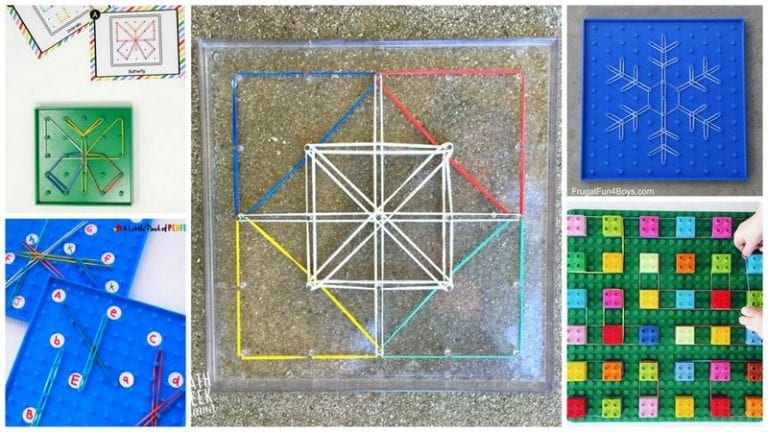
18 Clever Ways to Use Geoboards in the Classroom
Simple, classic, and fun. Every classroom needs these. Continue Reading
Copyright © 2024. All rights reserved. 5335 Gate Parkway, Jacksonville, FL 32256
Over 6,200 homeschool resources and growing!

33 Free Book Report Forms and Templates for Kids
Published: April 11, 2019

Contributor: Annette Breedlove
Disclosure: This post may contain affiliate links, meaning if you decide to make a purchase via my links, I may earn a commission at no additional cost to you. See my disclosure for more info.
I loved writing book reports growing up. My kids, however, do not share the same sentiment. They love to read books and retell the stories to me, but they have a disconnect when it comes to putting it down on paper. That’s why I love using a free book report template to give them a little extra help.

Fun Book Report Ideas
There are many different ways children can share about a book they read other than writing about it. Check out all of these fun ideas:
- Act it out. Young students and even older students may enjoy acting out a story that they read in lieu of writing about it.
- Make a 3D diorama . This is a great way for students who like to work with their hands and create visuals.
- Draw it out on a poster . For young kids who don’t have strong writing skills yet, drawing out what they read is a great option.
- Make a comic book with a free comic book template we have included below.
- Oral narration . Narrating back a brief summary of the book they read is another alternative to writing a book report. You can see if your children comprehended what they read or at least got the main points of the story by asking them basic questions about the book.
Types of Book Reports
If you prefer using book reports, they come in a variety of types and styles. You can write plain-Jane ones or get a little more creative, like the comic strip option below for a different way to format a book report. Whichever you choose, having the option to use a book report template can be helpful for kids.
While I enjoy book reports and see their value, I much prefer my kids enjoy reading a lot of books and sharing, over the finer points of proper form. So if we can use a simple book report template to keep them excited about reading and not dread the reports, I call that a win-win.
Mix it up with the different types of book reports that you assign to your children. Keep it fun and engaging and they will want to read more books and tell everyone about what they have read.
Using Book Report Templates
As with anything we print out for school, I like to find cute printables with book report designs and age-appropriate graphics. This is especially for my middle school-aged daughter, who thinks some of the free worksheets I find are too childish.
Using a book report template for 3rd grade might look a little different than what I’d want to use for 7th grade. A pdf book report template for high school students definitely needs to be less kid-friendly and more informative.
There are simple book report templates for beginning writers and more advanced ones. The options are endless when it comes to choosing a book report template for your homeschool children.
Printable Book Report Forms
Whether you are looking for a short book report template or one for high school, book report templates will help students get their thoughts on paper. They will learn to organize their thoughts so that their finished book report project is a success!
Book report templates can encourage all the readers in your homeschool to crank out an organized, thorough book report that they are proud of! Once you select a free template, you can get started. Let your children choose one of their favorite books for their first report as it will help to keep them engaged.
How to Use a Book Report Template
When you are looking for the perfect book report template, keep in mind the age of your child. Some one-page forms are perfect for young children and beginning readers with boxes to draw, lines to write down main characters, setting, the plot, etc.
When you have a high school student needing to write a paper or a book report, you obviously need something more in-depth. A book report template can help them get their ideas on paper well enough to organize thoughts and personal opinions for an essay, or even a research paper.
The key point of using worksheets for book reports is to have an easy way to get thoughts on paper. A book report template can help your student stay organized so they are able to draft a well-written paper. These types of graphic organizers make book reports a breeze!
What’s included in a book report?
- A good book report will consist of the book title, author’s name, main idea, main theme, plot points and important details.
- It will explain the narrative and setting, and cover the main elements of the story as well as describe important characters of the book.
- You’ll also want to include details on the time period, major conflicts and the book details, or rather a plot summary of the book.
- Don’t forget to include unusual facts and key elements that stand out.
Character Description
Besides adding basic details about the key characters in the book, it’s a good idea to include character details. You will want to include details such as; appearance, interests, and list out some adjectives that describe characters on the book report form .
Analyze what your character looks like so the reader of the book report gets a vivid description of the character. What color is their hair and skin? What is their clothing style like? Do they have a best friend or an animal that is constantly with them?
Is the character an animal? If so, what type of animal are they and what do they look like?
Character Development
Characters develop on in the story as you read about them. Make sure to make note of positive and negative character traits and how those change throughout the plot. Is there a hidden message or reason why the character is behaving the way that they are?
Make notes of how your character has changed and why you think they changed and the reasons for the actions that they took. You can take it a step further and explain how their actions either harmed or helped the story to move along.
Printable Book Report Templates and Forms
If you want a book report template quickly, simply scroll to the bottom of this post to download ours FREE.
DIY Book Report Kit {works with ANY book} This printable book report template is more like a graphic organizer , in my opinion. You can print several different template pages to organize different aspects of the book so you can create a great book report.
Free Book Report Template for Elementary Students Get your 1st -4th graders writing book reports with ease with these pdf book report pages.
Book Review Templates This cute pack of 5 different book report template pages would be perfect for early learners who know how to write .
Printable Book Report Form I like this simple book report template that’s perfect for a new reader. The free printable book report template is organized and will prompt your kids to be creative.
Elementary Book Reports Made Easy An easy one-page pdf download of a book report worksheet that would be good for elementary students.
Printable Book Report Forms (Non-Fiction, Fiction, Biography, Mystery & Fable) You have lots of different options for book report templates. Whether or not you need a book report form for a biography, non-fiction resource , or even a fable, there are several different pdf templates to choose from. There are also multiple book report poster forms for those kids who prefer to draw.
7 Different Versions of Book Report – If you are looking for different versions for different age levels or grades then these reports are worth reviewing.
Easy Book Report – This features an easy form for younger students as well as outline form for older students.
Book Report Templates for Younger Students
There are different styles of book report templates that you will want to focus on for younger students. A book report template that you use with your middle school aged child will be too difficult for beginning writers.
You will want to look for a book report format with dashed lines, boxes to draw a picture in, and more.
My Book Report Worksheets These book report worksheets are suitable for children in kindergarten or first grade.
Comic Strip Book Reports If you have a reluctant writer , or a comic book lover, these free printable comic strip book report templates will likely make a book report less dreaded!
Reading Logs and Bookmarks
Reading Log and Book Report Templates If you are on the hunt for cute reading log printables, these are perfect for elementary students. There are a few different templates that offer options to rate the book and write a review. Using a creative book report template like this might take the sting out of writing book reports for reluctant writers.
Free Reading Log and Book Report Forms My Joy-Filled Life has a 2-page book report template and a printable reading log that you can slip into your homeschool binder .
Free Reading Logs, Bookmarks and Charts – Encourage your readers with fun and colorful bookmarks and charts that they can use to track their reading time as well as the books they have read. Free Instant Download included!
Book Report Template
Book reports don’t have to be boring or something that your children dread. They may be overwhelmed because it is a new thing that they have never done before and may need just a little guidance to get started.
Our FREE DIY Book Report template pack includes four pages of graphic organizers, question prompts, illustration boxes, and more. It is a great start to guiding your children on how to write a book report in a non-threatening way.
You can download it for free in our subscriber library .
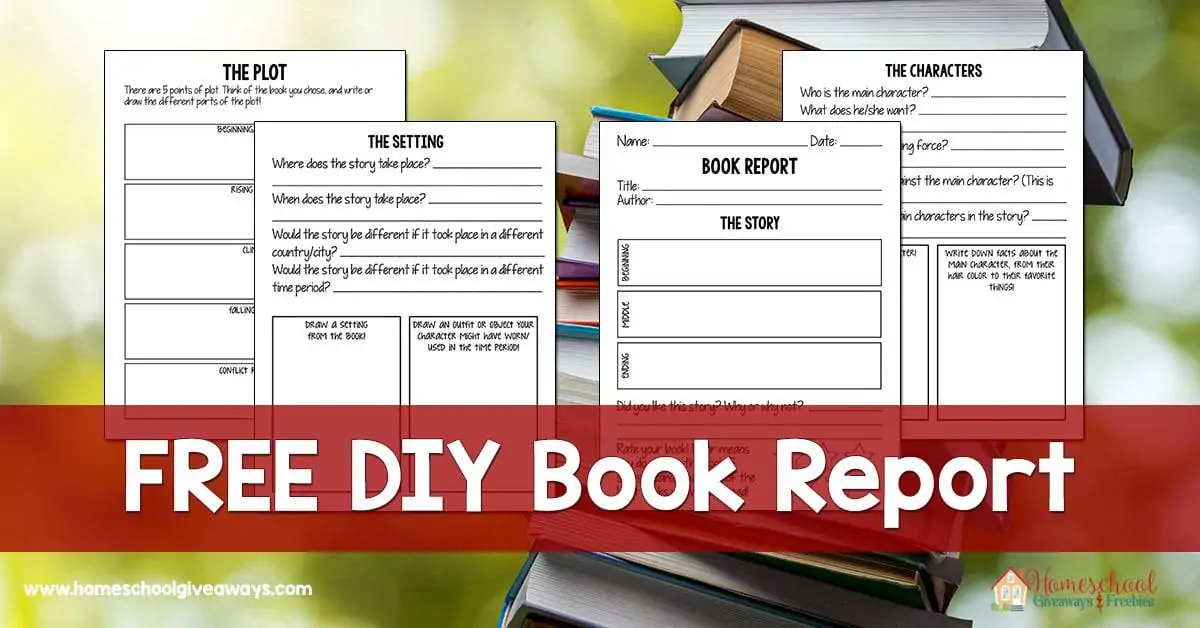
In Conclusion
The body of the book report should include the title, the author of the book, characters, setting, major conflicts, direct quotes, and plot. The conclusion can include a personal opinion. Book reports are a fun way to develop critical thinking skills and teach students how to gather information to format into a writing assignment.
Annette Breedlove
Annette has been married to her husband and best friend since 2003. Together they are raising their six children to follow the Lord’s will, no matter what. Annette longs for the day when she will meet her angel babies who have entered heaven before her. She enjoys creating UNIT STUDIES and FREE PRINTABLES for homeschool families. You can follow her crazy life at In All You Do where she blogs about homeschooling, homemaking and marriage while trying to maintain her sanity. She is also the owner of Thrifty Homeschoolers where she shares her tips on homeschooling without breaking the bank.
Related resources
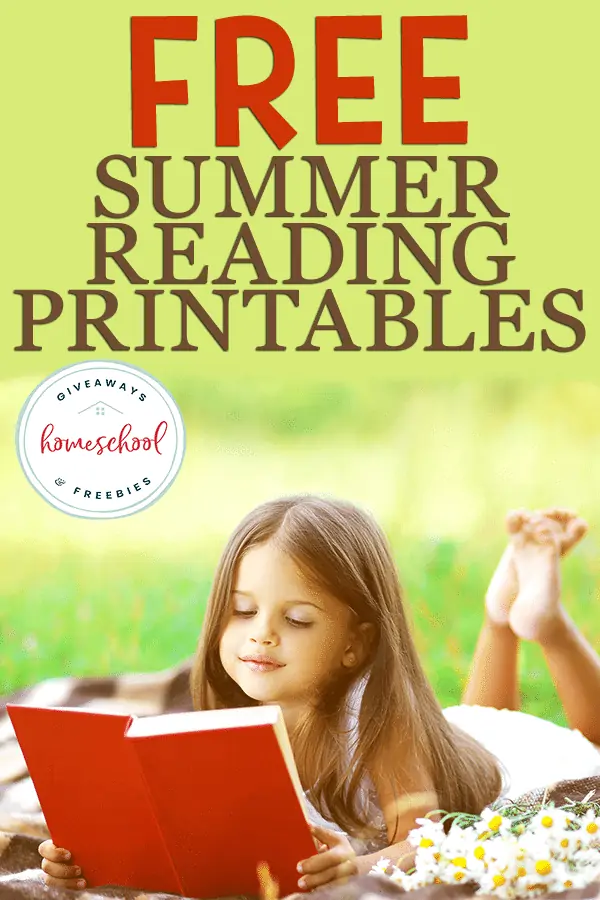
FREE Summer Reading Printables
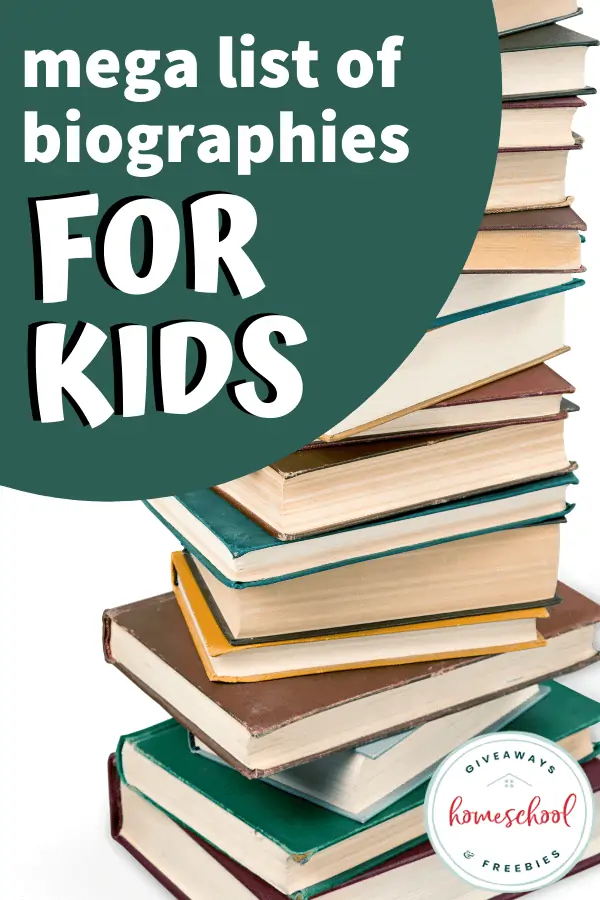
Mega List of Biographies for Kids
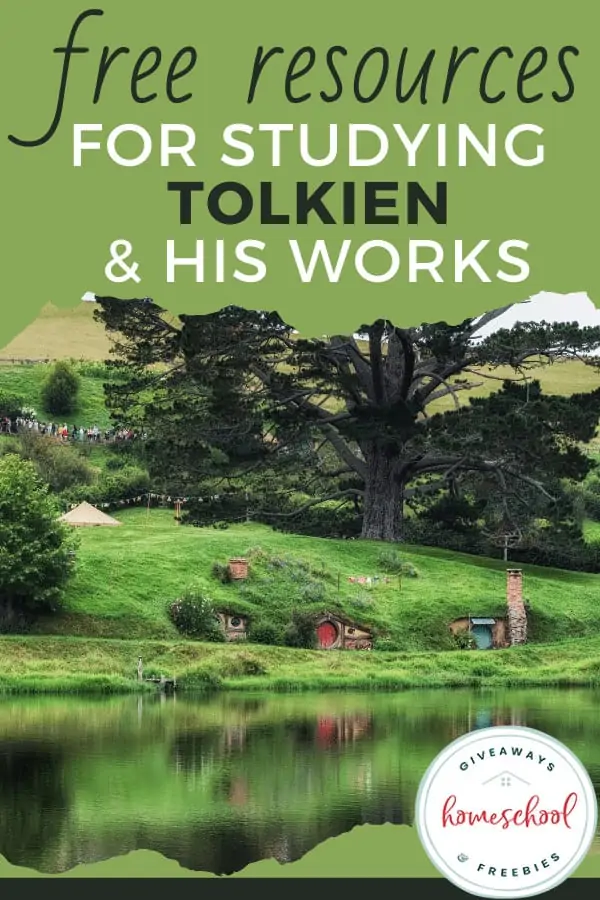
Free Resources for Studying Tolkien & His Works
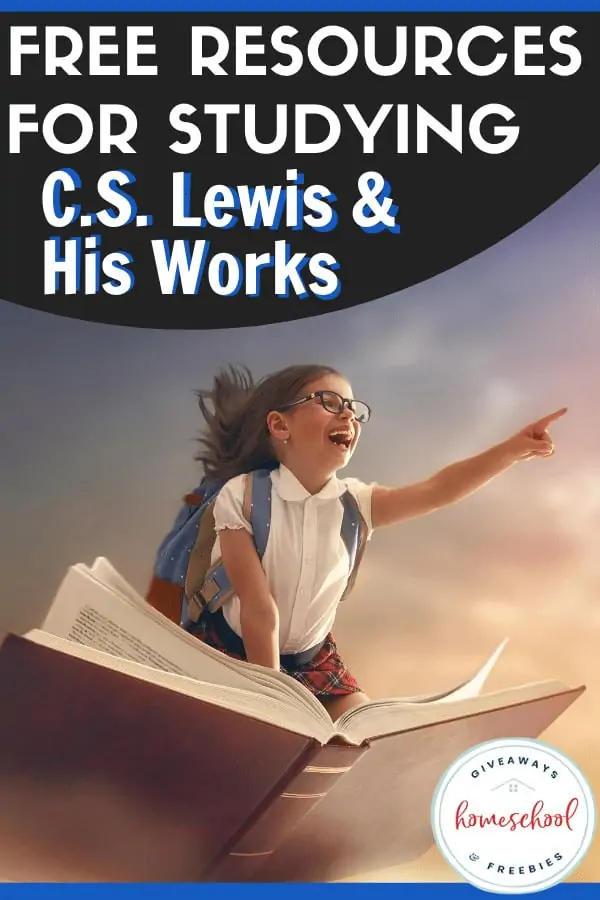
Free Resources for Studying C.S. Lewis & His Works

Tales from a Teacher’s Bookshelf + FREE Hardcover Book (Limited) & Giveaway

Mega List of Mystery Books for Kids

- Book Report Template
- Elementary Book Report Template
- 2nd Grade Book Report Template
2nd Grade Book Report - Fiction
ADVERTISEMENT

Related Articles
Related forms.

Related Categories
- 4th Grade Book Report Template
- Cereal Box Book Report Template
- Book Report Template 5th Grade
- Kindergarten Book Report Template
- Animal Report Template
- 3rd Grade Book Report Template
- Book Report Template Middle School
- Fiction Book Report Form
Please, turn your attention
By pressing 'print' button you will print only current page. To print the document completely, please, download it.
Book Report Template Brochure for 2nd 3rd 4th Grade - Fiction Book Report

Description
Are you tired of the same old routine when it comes to book reports? Have you been looking to change up your regular go-to book report template and engage your students in a more exciting way? This fun and unique template is set out as a travel-style brochure , welcoming readers to the main setting of the story.
In the brochure, students will:
- Summarize the story
- List main characters
- Identify villains
- Suggest settings to visit
- Suggest activities to do in the 'story setting'
- Provide cautions of characters/places things to avoid in the 'story setting'
- Share their favorite part
- Rate the book overall
- Write a comment from a character's perspective
- Include drawings and illustrations
What's Included:
- 2-Sided Trifold Brochure Template
- US Letter and A4 Sizes
- Color & Black and White Options
- More & Less Writing Lines for different grade levels
Perfect For:
- Unique Fiction Book Report: Stand out from traditional book reports with this creative and engaging format.
- No Prep, No Planning Activity: Say goodbye to tedious planning and preparation with this ready-to-use resource.
- Book Clubs: Foster lively discussions and deeper insights within your book club with this interactive tool.
- Using with Any Fiction Book: This versatile template can be applied to any fiction book, allowing for endless possibilities.
- Projects: Enhance project-based learning experiences with this dynamic and hands-on activity.
For Sensational Savings and Benefits
Follow my store to be notified of new products and sales. New products are 50% off for the first 24 hours!
⭐️ Leave a review on purchased products to earn credit to spend on TpT purchases!
___________________________________
Copyright © Teaching With Imagination
Permission to copy for single classroom use only.
Please purchase additional licenses if you intend to share this product.
Questions & Answers
Teaching with imagination.
- We're hiring
- Help & FAQ
- Privacy policy
- Student privacy
- Terms of service
- Tell us what you think
COMMENTS
With this 6-8th grade template, students write a two-sentence summary, important quotes and whether they recommend the book and why. 6th - 8th Grade Book Report Activity #2. Students explain, in two sentences, what the text is about, identify three important events in the text, and choose one quote they think is most important and then analyze ...
Take a new spin on your book report assignment with our free book report template printables including a one-pager, choice board, and more! ... Grades Grades. All Grades K-5 All Grades 6-12 PreK 6th Grade Kindergarten 7th Grade 1st Grade 8th Grade 2nd Grade 9th Grade 3rd Grade 10th Grade 4th Grade 11th Grade 5th Grade 12th ... My Mini Book ...
These fun, free printable book report template pages are perfect for older kids in 2nd grade, 3rd grade, 4th grade, 5th grade, and 6th grade students. Being no-prep, these book report forms help to ensure readers are understanding what they are reading. Simply print the printable book report template to write down information about the book ...
These free book report tempaltes allow grade 1, grade 2, grade 3, and grade 4 students to write a book report EASILY! Use the 2nd grade book report with guided prompts and ruled lines to make writing a book report easy for kids. Use as many of the pages in the free printable book report template as you think is appropriate for your child.
Grade 5-6 Story All Parts Book Report Template 01. Grade 5-6 Character and Setting Book Report Template 03. Grade 5-6 Character and Setting Book Report Template 04. Grade 5-6 Wh Questions Book Report Template 03. Grade 5-6 Story All Parts Book Report Template 02. Grade 5-6 Story All Parts Book Report Template 03.
Linked Topics. Second Grade Language Arts Reading Comprehension Book Review Sheet Book Report Template Elementary School Book Template Paper Templates Life. Download a free Second Grade Book Report Template in PDF or Word format. Fill it out online and save as a PDF or print it out for easy book reporting.
2nd Grade Book Report Templates. As your second-grade students begin to understand the purpose of a book report, they can go beyond reporting, and also answer book report questions that will add in their opinion. Opinion writing is a simple style to introduce alongside book reports as your students can easily tell if they enjoyed the book (or ...
2. Identify the main elements of the book. Scrutinize the book's primary components, including its main themes, characters, setting, and plot. These elements will form the basis of your report. 3. Formulate a thesis statement. Compose a thesis statement that encapsulates your personal perspective about the book.
Fiction Book Report Name Students Entering Second Grade Title Author Write a paragraph of five to eight sentences telling what your book was about. You must write this yourself. Remember what you have learned about having a beginning, middle, and ending in a paragraph.
Tell what happened in your own words. Don't just copy sentences. Add lots of details.Spelling is important. This is a summary -what happened in the beginning, middle, and end: You can use words like First,
2. 5Ws Book Report. The 5Ws book report template, which works well with fiction and nonfiction texts, is great for younger students because it guides them in answering basic questions derived from who, what, when, where, why, and how . Download template. After reading a book, students will generate questions using the question stems and answer ...
Retell the Story. If you seek easy, yet powerful, book report ideas for second graders, this project is a good fit. Using the 5Ws + H (who, what, when, where, why, how), or SWBST (Somebody Wanted But So Then), students will retell the book in their own words. They may record their information in a reader's notebook, or you may provide them ...
Find the perfect book report template printable for your kinder, first, and second grade class. Often, when we think of writing book reports, we think of older students. However, young children can also learn valuable elements of a book. It will also help them with reading comprehension and improve their writing skills. One thing to remember is to make it simple and fun. Our young students are ...
The body paragraphs of your book report accomplish several goals: they describe the plot, delve more deeply into the characters and themes that make the book unique, and include quotations and examples from the book. Below are some resources to help you succeed in summarizing and analyzing your chosen text.
This Book Report Bundle #2 contains 8 of my best-selling book reports perfect for 2nd, 3rd, 4th & 5th grade (at a $10 discount!). Each book report includes project description template with coordinating grading rubric. Most book report include sample photos of completed projects as well! 1. Board Game Book Report (students create a fun game!)2.
18. FREE. PDF. 6 different templates for 2nd graders to use to help give them ideas for book reports - 1 - Book Recommendation 2 - First, Next, Last 3 - Book Jacket 4 - Report Form 5 - Comic Strip 6 - Letter to Character Each of the templates allow for a child to be creative with words or artistic! Subjects:
15. Watercolor Rainbow Book Report. This is great for biography research projects. Students cut out a photocopied image of their subject and glue it in the middle. Then, they draw lines from the image to the edges of the paper, like rays of sunshine, and fill in each section with information about the person.
Elementary Book Reports Made Easy An easy one-page pdf download of a book report worksheet that would be good for elementary students. Printable Book Report Forms (Non-Fiction, Fiction, Biography, Mystery & Fable) You have lots of different options for book report templates. Whether or not you need a book report form for a biography, non ...
This Book Report Bundle #2 contains 8 of my best-selling book reports perfect for 2nd, 3rd, 4th & 5th grade (at a $10 discount!). Each book report includes project description template with coordinating grading rubric. Most book report include sample photos of completed projects as well! 1. Board Game Book Report (students create a fun game!)2.
Some book reports also ask critical viewpoints about events and characters to make sure that the students read the book completely. Also, by asking such questions students can understand the book better. Download Template (517 KB) Download Template (217 KB) Download Template (24 KB) Download Template (84 KB)
View, download and print 2nd Grade Book Report - Fiction pdf template or form online. 6 2nd Grade Book Report Templates are collected for any of your needs.
2-Sided Trifold Brochure Template. US Letter and A4 Sizes. Color & Black and White Options. More & Less Writing Lines for different grade levels. Perfect For: Unique Fiction Book Report: Stand out from traditional book reports with this creative and engaging format. No Prep, No Planning Activity: Say goodbye to tedious planning and preparation ...
The book report contains sections for the title, author and illustrator. The other sections include characters, setting, problem, solution and theme. These are the major parts of a book that this book report worksheet covers. It is important to learn the major terms that relate to the book you have read. This book report worksheet helps you to ...